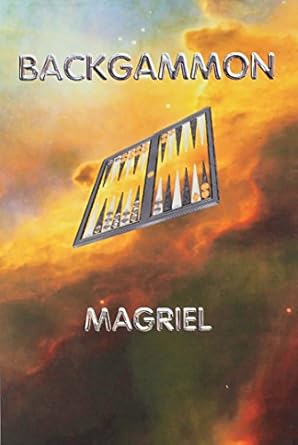by Albert Steg
This annotated bibliography is arranged in thematic sections according to topical focus or, at times, instructional style. Within each section, you will find the books are listed chronologically. While most entries are intended to provide students of the game a guide to choosing the books they most need, a second purpose is to trace the history of backgammon theory and competitive practices over time, beginning in the 1920’s when doubling was first introduced. Therefore many books are included whose practical value for the modern player is minimal (and in a few cases were never very useful to begin with), and it’s generally fair to say that the older a book is, the greater the skepticism you should apply to its lessons. However, several of the great texts from the pre-bot era (particularly those by Magriel, Dwek, and Robertie) hold up very well in their essential wisdom, even if some of their particular examples have been overturned by computer referees. What’s more, skilled prose backed up by meticulous editing and professional book design were more common in the decades before 2010, before internet commerce made DIY publication so easy. There have been a flood of new backgammon books published in recent years, perhaps ushered in by the idle times of the Covid years. All offer valuable material of practical value — but relatively few match the eloquence and visual clarity of the great 1970’s writers like Cooke, Holland, and Deyong. It should also be remembered that these earlier writers generated their mastery out of pure self-study and hard-fought experience, without looking to XG to verify their ideas or guide their analysis. It’s a lot easier (and safer) to write a backgammon book with XG to tell you what all the answers are!
The opinions presented are my own. I look to find merit in each entry while acknowledging substantial defects.
Where an author is associated with an online store or has requested a link to a favored vendor, the cover image has been linked to that site. Many of the titles currently in print may also be purchased from one or more of the backgammon distributors below.
Backgammon ala Carte (Carol Joy Cole)
Backgammon Galaxy Shop (Marc Olsen)
The Fortuitous Press (Jeremy Bagai)
The Gammon Press (Bill Robertie)
Roadkill Books (Roberto & Irina Litzenberger)
Click on the ‘+’ symbol by a book title to read a brief review. Recent additions to the page will be displayed in the “open” state for a few months.
The One Essential Book
Backgammon (1976) - Paul Magriel
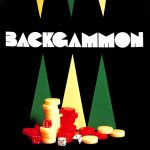 In a category all by itself, Paul Magriel’s Backgammon is often called “The backgammon bible.” It is the one indispensable book for all students of the game. Magriel was the first to thoroughly systematize the essential strategic game types (Running, Holding, Priming Attacking) and to articulate, with vivid clarity, many of the concepts (“Golden Point,” “Safe Play vs. Bold Play”) that form the vocabulary of modern backgammon analysis.
In a category all by itself, Paul Magriel’s Backgammon is often called “The backgammon bible.” It is the one indispensable book for all students of the game. Magriel was the first to thoroughly systematize the essential strategic game types (Running, Holding, Priming Attacking) and to articulate, with vivid clarity, many of the concepts (“Golden Point,” “Safe Play vs. Bold Play”) that form the vocabulary of modern backgammon analysis.
Novices with a determined, studious bent will find Magriel an excellent starting place, but the sheer bulk of the tome may intimidate or overwhelm many beginners.
Pictured here is the iconic 1976 hardcover edition. The book has been re-issued in a 2004 soft-cover edition, with a new forward by Renee Magriel Roberts, who is also now credited as co-author.
For Novice Players
Here are books to pique the interest of a friend or to begin your journey towards backgammon mastery. Beginning players might also enjoy reading some of the general theory books in the next section, particularly Oswald & Jacoby’s The Backgammon Book, Cooke’s The Cruelest Game, and of course Magriel.
Backgammon For Winners (2002, 3rd Edition) - Bill Robertie
 Bill Robertie is one of the few backgammon theorists who writes effectively for players at all levels of experience, and this beginner’s book is probably the best practical introduction to the game of the modern era. Beyond all the requisite details of board set-up and rules, Robertie introduces essential strategies and tactics along with just enough in the way of probability and doubling theory to open up the subtleties of the game without overwhelming the novice reader. He also walks us through two complete sample games, revealing the excitement and intrigue available from backgammon, a teaching method oddly lacking from most beginner’s books.
Bill Robertie is one of the few backgammon theorists who writes effectively for players at all levels of experience, and this beginner’s book is probably the best practical introduction to the game of the modern era. Beyond all the requisite details of board set-up and rules, Robertie introduces essential strategies and tactics along with just enough in the way of probability and doubling theory to open up the subtleties of the game without overwhelming the novice reader. He also walks us through two complete sample games, revealing the excitement and intrigue available from backgammon, a teaching method oddly lacking from most beginner’s books.
Backgammon Boot Camp (2004) - Walter Trice
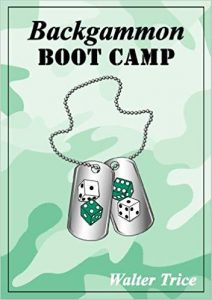 Backgammon Boot Camp started life as a series of articles Walter Trice wrote for the online backgammon magazine GammonVillage (still an excellent resource!). Walter’s series was called “Beginners’ Boot Camp,” and each of the articles (now chapters) presents a pithy, very practical tool, idea, or technique for making the right decisions in all phases of the game. Accomplished players too will find challenging and valuable new material here, particularly in the quantitative sophistication of Trice’s Effective Pipcount, a technique for evaluating racing efficiency that has been so widely embraced that ‘EPC’ is a metric displayed on eXtreme Gammon’s coaching screen, right next to the raw pip count. Beginners should not be put off by the complexity and mathematical subtlety of some of these later chapters, but rather focus on the chapters that they find most accessible and leave these others for later in their backgammon career.
Backgammon Boot Camp started life as a series of articles Walter Trice wrote for the online backgammon magazine GammonVillage (still an excellent resource!). Walter’s series was called “Beginners’ Boot Camp,” and each of the articles (now chapters) presents a pithy, very practical tool, idea, or technique for making the right decisions in all phases of the game. Accomplished players too will find challenging and valuable new material here, particularly in the quantitative sophistication of Trice’s Effective Pipcount, a technique for evaluating racing efficiency that has been so widely embraced that ‘EPC’ is a metric displayed on eXtreme Gammon’s coaching screen, right next to the raw pip count. Beginners should not be put off by the complexity and mathematical subtlety of some of these later chapters, but rather focus on the chapters that they find most accessible and leave these others for later in their backgammon career.
Every reader will enjoy Trice’s lively prose, anecdotal illustrations, and vivid metaphors — despite the title, Chapter one presents backgammon not as a battle, but a roller derby!
52 Great Backgammon Tips (2007) - Patti Beadles & Kit Woolsey
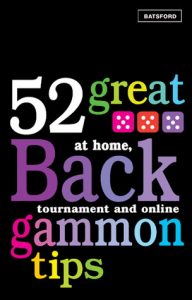 This is a terrifically fun primer that offers up pithy, memorable backgammon advice in 52 readily digestible servings. While the writing is light and engaging, the advice is rock-solid. Each chapter is vividly titled (“Learn to Count Shots,” “Rip Checkers Off,” “Double Volatile Positions”), making it a natural for browsing, but the material is presented in a careful sequence of increasing sophistication, so any player in the Beginner-Intermediate zone can skim over earlier, more obvious material if they like, and dig in when they discover new ideas. And even more experienced players can enjoy this book, if only to hear their intuitive perceptions of proper play made explicit.
This is a terrifically fun primer that offers up pithy, memorable backgammon advice in 52 readily digestible servings. While the writing is light and engaging, the advice is rock-solid. Each chapter is vividly titled (“Learn to Count Shots,” “Rip Checkers Off,” “Double Volatile Positions”), making it a natural for browsing, but the material is presented in a careful sequence of increasing sophistication, so any player in the Beginner-Intermediate zone can skim over earlier, more obvious material if they like, and dig in when they discover new ideas. And even more experienced players can enjoy this book, if only to hear their intuitive perceptions of proper play made explicit.
Backgammon in 10 Minutes (2013) - Brian Byfield & Gray Joliffe
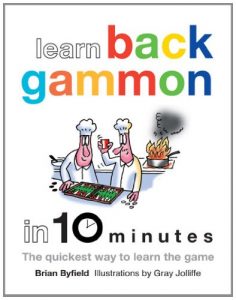 Here’s a perfect book for introducing a friend or family member, young or old, to the game of backgammon. This book covers everything they will need to know to get playing, and presents the basics by means of simple diagrams paired enlivened by delightful cartoon drawings by popular illustrator Gray Joliffe. The book also introduces basic concepts like priming and duplication, and even explains the Jacoby Rule and beavering in its brief treatment of the doubling cube. For the vast majority of people out there who aren’t already gaming aficionados, this is the gentlest, most inviting intro you could ask for.
Here’s a perfect book for introducing a friend or family member, young or old, to the game of backgammon. This book covers everything they will need to know to get playing, and presents the basics by means of simple diagrams paired enlivened by delightful cartoon drawings by popular illustrator Gray Joliffe. The book also introduces basic concepts like priming and duplication, and even explains the Jacoby Rule and beavering in its brief treatment of the doubling cube. For the vast majority of people out there who aren’t already gaming aficionados, this is the gentlest, most inviting intro you could ask for.
Backgammon To Win (2018, Revised) - Chris Bray
 The popular “. . . for Dummies” instructional series tapped respected British backgammon author Chris Bray, to lay out the game in an appealing, accessible way for the beginning player, and this is Bray’s more traditional presentation of that material. This fine introductory text covers a broad range of topics germane to playing backgammon at tournaments, in local chouettes and “money games” as well as online, so this isn’t just a book about how to play the checkers and when to deploy the doubling cube: it’s a practical guide to entering the whole wide world of backgammon beyond your kitchen table.
The popular “. . . for Dummies” instructional series tapped respected British backgammon author Chris Bray, to lay out the game in an appealing, accessible way for the beginning player, and this is Bray’s more traditional presentation of that material. This fine introductory text covers a broad range of topics germane to playing backgammon at tournaments, in local chouettes and “money games” as well as online, so this isn’t just a book about how to play the checkers and when to deploy the doubling cube: it’s a practical guide to entering the whole wide world of backgammon beyond your kitchen table.
The Language of Backgammon (2019) - Bob Wachtel
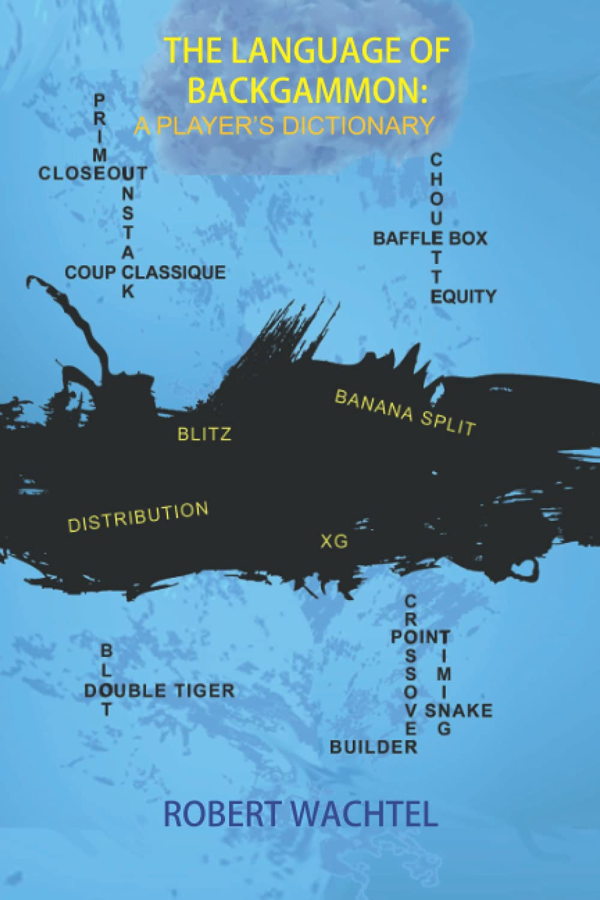 There’s plenty of jargon peculiar to backgammon, and you’ll find that many writers assume knowledge of the terminology common to seasoned players. Bob Wachtel has put together this useful “player’s dictionary” of terms we all need to know. As an aficionado of backgammon history, I wish he had mined a deeper seam of backgammon lore by checking obsolete texts for some of the charmingly outdated terms of the 1930’s — like my favorite : “Booby Point” for the opponent’s bar-point, owing to the difficulty of leaving it. (The term “Lover’s Leap” also hails from that time, credited to a “backgammonist” named Mrs. Curtis, of new York.) And why not include some of the idiosyncratic terms that never caught on, such as Peter Bell’s “cashers” (for market-losers)? But Wachtel’s book is aimed at usefulness, not amusement and useful it will prove for any aspiring player. Wachtel offers plenty of anecdotal amusement and entertainment in his Backgammon Chronicles, cited elsewhere on this page.
There’s plenty of jargon peculiar to backgammon, and you’ll find that many writers assume knowledge of the terminology common to seasoned players. Bob Wachtel has put together this useful “player’s dictionary” of terms we all need to know. As an aficionado of backgammon history, I wish he had mined a deeper seam of backgammon lore by checking obsolete texts for some of the charmingly outdated terms of the 1930’s — like my favorite : “Booby Point” for the opponent’s bar-point, owing to the difficulty of leaving it. (The term “Lover’s Leap” also hails from that time, credited to a “backgammonist” named Mrs. Curtis, of new York.) And why not include some of the idiosyncratic terms that never caught on, such as Peter Bell’s “cashers” (for market-losers)? But Wachtel’s book is aimed at usefulness, not amusement and useful it will prove for any aspiring player. Wachtel offers plenty of anecdotal amusement and entertainment in his Backgammon Chronicles, cited elsewhere on this page.
General Theory, Models, Approaches
Books in this section either make an attempt to cover the entire game of backgammon, including most of the essential analytical tools required to achieve an all-around expertise in checker play and cube action — or they offer a unique approach to the game based upon some particular model or theory of backgammon. Popular books from the great backgammon publishing booms of the 1930’s and 1970’s rely heavily on the reputation and charisma — and sheer chutzpah! — for their credibility, so books from this era tend to have a lot of personality. They often feature plenty of colorful anecdotes and character depictions, as in these pre-bot days there was a far greater sense of “playing your opponent” rather than making the robotic play. This makes them fun to read, even when outdated or wrongheaded .
Vanity Fair's Backgammon To Win (1930) - Georges Mabardi
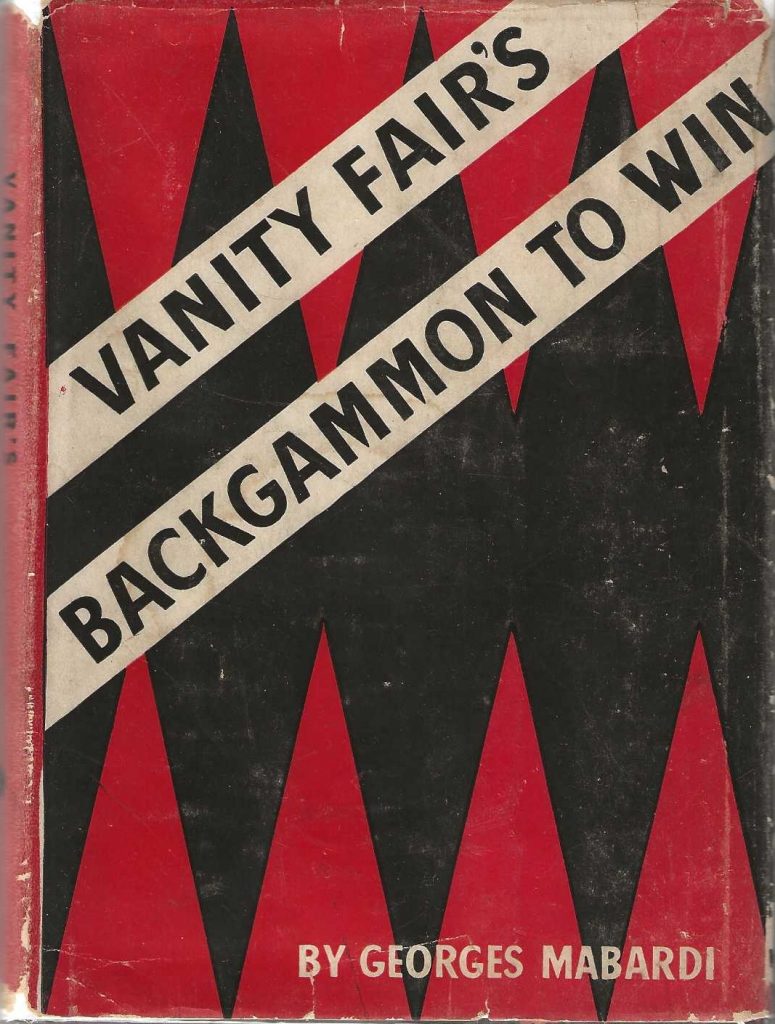 Mabardi’s conception of the game is fascinating and conveyed with style, clarity, and most of all, complete conviction. (Perhaps only Bruce Becker has written with such dismissive certainty.) He presents the player as a military commander withdrawing his troops from the field: “backgammon is always a game of retreat, never of advance” (p.31). This model of the game provides the logic behind the “Middle East style” of play, where both back men are advanced with a host of opening rolls (64, 63, 62, 43, 41, 32) — and slotting is rejected as foolishness. Mabardi is equally dismissive of the entire notion of doubling, which he views as a mere gambler’s fad. Having failed to grasp the “25% rule” (along with most backgammon writers in 1930), he proclaims “. . . if two absolutely perfect players engaged in a match, there would never be an accepted double . . . The author’s chief objection to the double is precisely this — its only raison d’être is the incompetent play of those who use it. For there can be no final difference of opinion on the value of position; . . . two expert players will never disagree.” Many other passages make for amusing reading, particularly a chapter on etiquette in which he laments the annoying behavior of the chortler, the grouser, and the coaxer among others. This book was re-issued in 1974 to capitalize on American backgammon’s second wave — but sadly, they for some reason omitted the delightful art deco illustrations of martini glasses, cigarettes, and other stylish items that accompanied the board diagrams. Pictured here is the original hardback with a rare dust jacket intact. For a more thorough account of this book and others from this era, see the 1930’s Chronology.
Mabardi’s conception of the game is fascinating and conveyed with style, clarity, and most of all, complete conviction. (Perhaps only Bruce Becker has written with such dismissive certainty.) He presents the player as a military commander withdrawing his troops from the field: “backgammon is always a game of retreat, never of advance” (p.31). This model of the game provides the logic behind the “Middle East style” of play, where both back men are advanced with a host of opening rolls (64, 63, 62, 43, 41, 32) — and slotting is rejected as foolishness. Mabardi is equally dismissive of the entire notion of doubling, which he views as a mere gambler’s fad. Having failed to grasp the “25% rule” (along with most backgammon writers in 1930), he proclaims “. . . if two absolutely perfect players engaged in a match, there would never be an accepted double . . . The author’s chief objection to the double is precisely this — its only raison d’être is the incompetent play of those who use it. For there can be no final difference of opinion on the value of position; . . . two expert players will never disagree.” Many other passages make for amusing reading, particularly a chapter on etiquette in which he laments the annoying behavior of the chortler, the grouser, and the coaxer among others. This book was re-issued in 1974 to capitalize on American backgammon’s second wave — but sadly, they for some reason omitted the delightful art deco illustrations of martini glasses, cigarettes, and other stylish items that accompanied the board diagrams. Pictured here is the original hardback with a rare dust jacket intact. For a more thorough account of this book and others from this era, see the 1930’s Chronology.
Complete Backgammon (1931) - Walter L. Richard
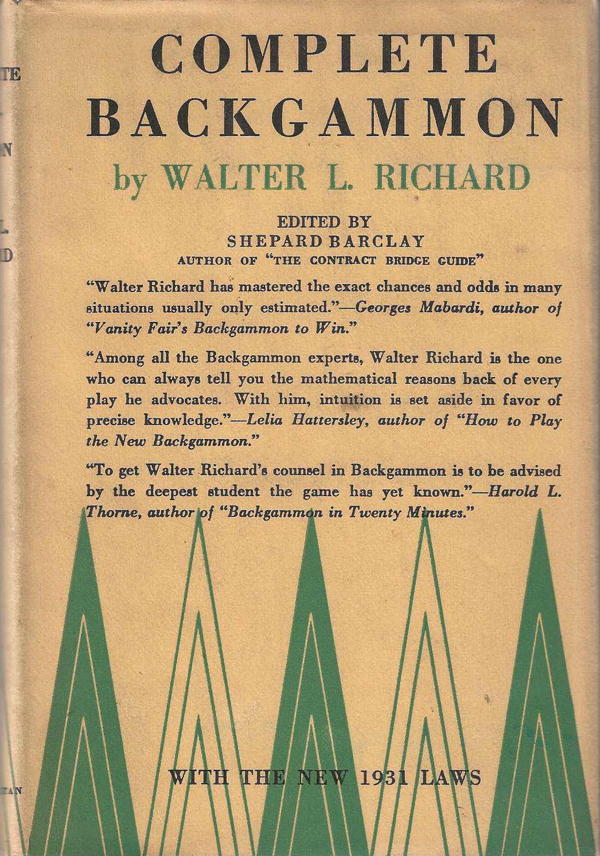 While each of the many backgammon writers of the 1930-31 boom regarded themselves as “authorities” on the game, Walter Richard seems to have had the final word. His book includes the Laws of Backgammon as codified and published by the Racquet and Tennis Club of New York that year, supplanting the various “official” rules that had been attempted in the preceding twelve months. After a short chapter on chouette rules, he provides an extended section on various species of tournament competition including North-South, elimination, round robin, club championships, team matches and inter-club leagues — a fascinating peek into the modes of competition in the private clubs of the day. Richards’ most substantive and long-standing revelation is his confident exposition of the 3-to-1 odds a player enjoys when accepting a double. What we now know as “the 25% rule” was in circulation at the time, but was flatly rejected by the other major writers who addressed it. So Walter Richard might be regarded as the grandfather of the doubling window! This is the only book of its time to remain in print for the ensuing decade, and a softback copy was often included in portable backgammon sets in the late 1930’s. For a more thorough account of this book and others from this era, see the 1930’s Chronology.
While each of the many backgammon writers of the 1930-31 boom regarded themselves as “authorities” on the game, Walter Richard seems to have had the final word. His book includes the Laws of Backgammon as codified and published by the Racquet and Tennis Club of New York that year, supplanting the various “official” rules that had been attempted in the preceding twelve months. After a short chapter on chouette rules, he provides an extended section on various species of tournament competition including North-South, elimination, round robin, club championships, team matches and inter-club leagues — a fascinating peek into the modes of competition in the private clubs of the day. Richards’ most substantive and long-standing revelation is his confident exposition of the 3-to-1 odds a player enjoys when accepting a double. What we now know as “the 25% rule” was in circulation at the time, but was flatly rejected by the other major writers who addressed it. So Walter Richard might be regarded as the grandfather of the doubling window! This is the only book of its time to remain in print for the ensuing decade, and a softback copy was often included in portable backgammon sets in the late 1930’s. For a more thorough account of this book and others from this era, see the 1930’s Chronology.
The Backgammon Book (1970) - Oswald Jacoby & John R. Crawford
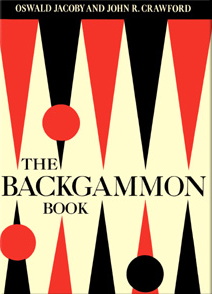 Although backgammon knowledge and practice have come a long, long way since 1970, The Backgammon Book remains one of the most effective introductions to competitive backgammon: fundamentals of dice probability, pip-counting, the “25% rule” for accepting doubles, and the concept of fair-settlement “equity” value inherent in a position are all here. Employing these kinds of tools is perhaps the defining difference between the novice and intermediate player. In addition to the usual coverage of tactics and strategy, Jacoby and Crawford provide an interesting chapter, full of pictures, of the game’s ancient — and modern — history, as well as chapters devoted to the social aspects of the game: general etiquette, chouette practices (now largely outdated), tournament practices, and popular rule variations. As this introductory text doesn’t delve too deep into the complexities of the game, only a very few positions have proven to be inaccurate by modern computer analysis (#’s 47, 55, 71, 77).
Although backgammon knowledge and practice have come a long, long way since 1970, The Backgammon Book remains one of the most effective introductions to competitive backgammon: fundamentals of dice probability, pip-counting, the “25% rule” for accepting doubles, and the concept of fair-settlement “equity” value inherent in a position are all here. Employing these kinds of tools is perhaps the defining difference between the novice and intermediate player. In addition to the usual coverage of tactics and strategy, Jacoby and Crawford provide an interesting chapter, full of pictures, of the game’s ancient — and modern — history, as well as chapters devoted to the social aspects of the game: general etiquette, chouette practices (now largely outdated), tournament practices, and popular rule variations. As this introductory text doesn’t delve too deep into the complexities of the game, only a very few positions have proven to be inaccurate by modern computer analysis (#’s 47, 55, 71, 77).
Backgammon - The Cruelest Game (1974) - Barclay Cooke & Jon Bradshaw
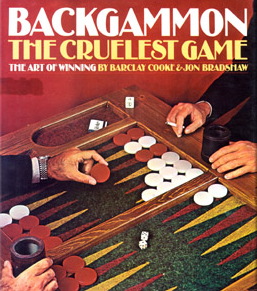 This is one of the great backgammon books of the 1970’s, and its aesthetic qualities will do more to inspire a newish player to embrace backgammon than many “stronger” introductory texts written in the 21st century. The writing is eloquent, the diagrams elegant, the typeface and graphics gorgeous. Each chapter opens with a relevant quotation from Clausewitz on war. But there is no getting around the fact that much of Cooke’s guidance is outdated. A 5-3 opening roll should be played 13/10 13/8 because “At this point in the game the 3 point is almost irrelevant.” Particularly dangerous (because so plausibly compelling) are Cooke’s free-slotting, anti-splitting, re-circulating tenets of “pure play,” which would be thoroughly refuted over the decades to come. Still, the book captures the energy and thrill of backgammon competition, and the sections on settlements (oddly absent from most modern treatises on the game), chouettes, and psychology are always interesting to read, as are the three “great games” presented in the final chapter, for what they preserve about backgammon as played before games were commonly transcribed.
This is one of the great backgammon books of the 1970’s, and its aesthetic qualities will do more to inspire a newish player to embrace backgammon than many “stronger” introductory texts written in the 21st century. The writing is eloquent, the diagrams elegant, the typeface and graphics gorgeous. Each chapter opens with a relevant quotation from Clausewitz on war. But there is no getting around the fact that much of Cooke’s guidance is outdated. A 5-3 opening roll should be played 13/10 13/8 because “At this point in the game the 3 point is almost irrelevant.” Particularly dangerous (because so plausibly compelling) are Cooke’s free-slotting, anti-splitting, re-circulating tenets of “pure play,” which would be thoroughly refuted over the decades to come. Still, the book captures the energy and thrill of backgammon competition, and the sections on settlements (oddly absent from most modern treatises on the game), chouettes, and psychology are always interesting to read, as are the three “great games” presented in the final chapter, for what they preserve about backgammon as played before games were commonly transcribed.
Backgammon for Blood! (1974) - Bruce Becker
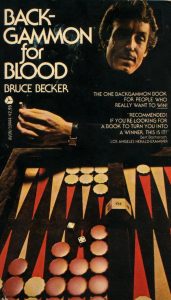 Backgammon for Blood! is possibly the most dangerous book ever written about the game. It’s not just that Becker’s suggestions are wrong-headed (Walter Trice memorably commented “Becker’s map of the world is missing a couple of continents.”) — but that he writes with such swaggering certainty that he’s likely to bend impressionable readers to his will. What to make of a man who eschews an open 65 “Lover’s Leap” as “dull and plodding,” preferring to play two down from the midpoint? The book is a pure study in money-game machismo, and reads best in a Schwarzenegger voice. Becker on the Jacoby Rule: “. . . all it does is coddle the lesser player; I don’t think he should stay out late at night playing backgammon if he needs that kind of protection.” This is also a book best purchased in paperback — the cover is priceless, even if it omits the exclamation point.
Backgammon for Blood! is possibly the most dangerous book ever written about the game. It’s not just that Becker’s suggestions are wrong-headed (Walter Trice memorably commented “Becker’s map of the world is missing a couple of continents.”) — but that he writes with such swaggering certainty that he’s likely to bend impressionable readers to his will. What to make of a man who eschews an open 65 “Lover’s Leap” as “dull and plodding,” preferring to play two down from the midpoint? The book is a pure study in money-game machismo, and reads best in a Schwarzenegger voice. Becker on the Jacoby Rule: “. . . all it does is coddle the lesser player; I don’t think he should stay out late at night playing backgammon if he needs that kind of protection.” This is also a book best purchased in paperback — the cover is priceless, even if it omits the exclamation point.
Backgammon (1976) - Paul Magriel & Renee Magriel Roberts (2004 edition)
Paul Magriel’s 1974 treatise, simply titled Backgammon, is often called “The backgammon bible.” It is the one indispensable book for all students of the game. Magriel was the first to thoroughly systematize the essential strategic game types (Running, Holding, Priming Attacking) and to articulate, with vivid clarity, many of the concepts (“Golden Point,” “Safe Play vs. Bold Play”) that form the vocabulary of modern backgammon analysis. Although some of the specific positions in the book have proven to be technically off the mark by the modern robots, the underlying principles have endured as bedrock knowledge for the serious player.
The book has been re-issued in a 2004 soft-cover edition, pictured here, with a new forward by Renee Magriel Roberts, who is also now credited as co-author.
Vision Laughs at Counting / Advice to the Dicelorn et al. (1980-96) - Danny Kleinman
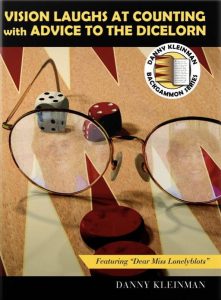 The title of Danny Kleinman’s first book is his most poetic and most playful, because clearly this is a write who enjoys counting. Over the course of sixteen years and twelve lengthy compilations of his backgammon writing, Kleinman offers plenty of vision and counting — and laughs. Celebrated as one of the most numerate and mathematical theoreticians of backgammon, Kleinman also delights in describing the social and psychological aspects of the game, often to hilarious effect. Kleinman’s highly technical articles are leavened by more immediately practical ‘Dear Abby’-style exchanges with “Miss Lonelyblots” and a host of other amusing backgammon personae. Kleinman’s books have been repeatedly reissued, most recently in nicely formatted hardback, spiral, or softback versions, and can also be purchased for iPad viewing via Applebooks.
The title of Danny Kleinman’s first book is his most poetic and most playful, because clearly this is a write who enjoys counting. Over the course of sixteen years and twelve lengthy compilations of his backgammon writing, Kleinman offers plenty of vision and counting — and laughs. Celebrated as one of the most numerate and mathematical theoreticians of backgammon, Kleinman also delights in describing the social and psychological aspects of the game, often to hilarious effect. Kleinman’s highly technical articles are leavened by more immediately practical ‘Dear Abby’-style exchanges with “Miss Lonelyblots” and a host of other amusing backgammon personae. Kleinman’s books have been repeatedly reissued, most recently in nicely formatted hardback, spiral, or softback versions, and can also be purchased for iPad viewing via Applebooks.
Backgammon for Serious Players (1997) - Bill Robertie
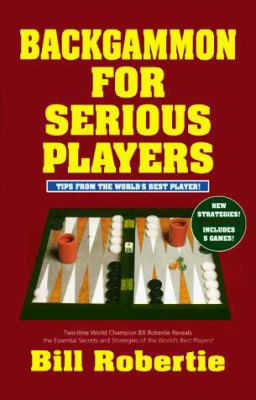 An excellent book for the aspiring intermediate player, Backgammon for Serious Players offers five illustrative games carefully selected to demonstrate a wide range of specific backgammon skills and concepts essential for achieving an expert level of play. (Killing numbers, recirculating checkers, duplication, saving the gammon, etc.) Pithy and memorable aphorisms guiding proper play are called out in bold text boxes, rules of thumb that will stay with the attentive reader and pay real dividends over the board. Readers should set up their own board (ideally, in XG, so you can see the cost of your mistakes) and play through each game as a quiz, marking positions you get wrong for follow-up review.
An excellent book for the aspiring intermediate player, Backgammon for Serious Players offers five illustrative games carefully selected to demonstrate a wide range of specific backgammon skills and concepts essential for achieving an expert level of play. (Killing numbers, recirculating checkers, duplication, saving the gammon, etc.) Pithy and memorable aphorisms guiding proper play are called out in bold text boxes, rules of thumb that will stay with the attentive reader and pay real dividends over the board. Readers should set up their own board (ideally, in XG, so you can see the cost of your mistakes) and play through each game as a quiz, marking positions you get wrong for follow-up review.
Note that newer printings of the book have only 200 pages, whereas the original version advertised on The Gammon Press had 256. The discrepancy is simply a matter of re-formatting by the publisher, to save on printing costs. The editions are otherwise the same.
Backgammon: From Basics to Badass (2015) - Marc Olsen
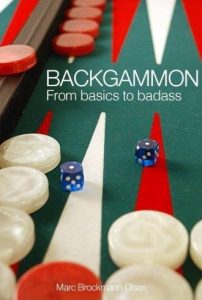 While this weighty text indeed covers the basic rules and fundamental ideas of the game, it is hardly intended for the beginning player. Rather, this almost encyclopedic overview of backgammon concepts, techniques, and strategies is perfect for the player who has already engaged in substantial competitive match or money play but has yet to acquire the terminology and working tools required for Open-level (expert) play. While it can be read sequentially, cover to cover, in an intense immersion in backgammon theory, it will be difficult for most players to absorb, retain, and apply such a flood of knowledge all at once. A better approach might be to read one, or a few, sections at a time and then spend time focusing on these few particular aspects of the game while playing practice matches online or against software programs like eXtreme Gammon.
While this weighty text indeed covers the basic rules and fundamental ideas of the game, it is hardly intended for the beginning player. Rather, this almost encyclopedic overview of backgammon concepts, techniques, and strategies is perfect for the player who has already engaged in substantial competitive match or money play but has yet to acquire the terminology and working tools required for Open-level (expert) play. While it can be read sequentially, cover to cover, in an intense immersion in backgammon theory, it will be difficult for most players to absorb, retain, and apply such a flood of knowledge all at once. A better approach might be to read one, or a few, sections at a time and then spend time focusing on these few particular aspects of the game while playing practice matches online or against software programs like eXtreme Gammon.
Backgammon: Pure Strategy (2017) - Marc Olsen
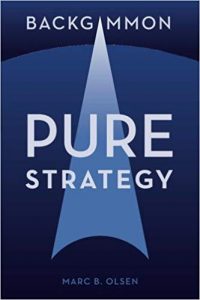 This provocative modern book tends to divide readers quite sharply. Some disdain it (in part because the English is poorly rendered), while many others swear by it. Olsen claims to offer a bold new method of thinking about backgammon, based on the neural network AI technique underlying strong backgammon programs like XG. The result is “The Value Equation,” which evaluates the combined game-plan strength of any position (Prime + Blitz + Race + Contact) and thereby guides checker play and cube decisions. If his method is as powerful as he claims, and if many readers can internalize it, the book may enhance our evolving understanding of the game. The jury is out, and will be for a good while. So approach this text with caution, but . . . ignore it at your peril?
This provocative modern book tends to divide readers quite sharply. Some disdain it (in part because the English is poorly rendered), while many others swear by it. Olsen claims to offer a bold new method of thinking about backgammon, based on the neural network AI technique underlying strong backgammon programs like XG. The result is “The Value Equation,” which evaluates the combined game-plan strength of any position (Prime + Blitz + Race + Contact) and thereby guides checker play and cube decisions. If his method is as powerful as he claims, and if many readers can internalize it, the book may enhance our evolving understanding of the game. The jury is out, and will be for a good while. So approach this text with caution, but . . . ignore it at your peril?
The Theory of Backgammon (2021) - Dirk Schiemann
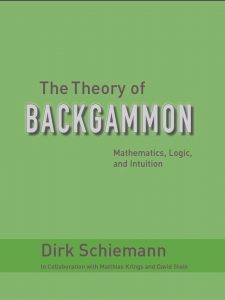 The “theory” laid out in this weighty tome isn’t for the serious beginner looking to start from the ground up with the basics. Rather, Schiemann lays out the mathematical considerations that govern optimal play in match and money play situations before pursuing a series of deep dives into a whole slate of specialized situations that bedevil already expert players looking to achieve world-class skills: doubling windows, cube efficiency, checker-play implications of cube ownership, adjusting play against stronger or weaker opponents, etc. Unlike many recent publications in backgammon, this handsome hardback book is professionally designed and typeset, reflecting the care Schiemann has taken with his analysis and editing, justifying the high price tag for those committed enough to seriously study its contents.
The “theory” laid out in this weighty tome isn’t for the serious beginner looking to start from the ground up with the basics. Rather, Schiemann lays out the mathematical considerations that govern optimal play in match and money play situations before pursuing a series of deep dives into a whole slate of specialized situations that bedevil already expert players looking to achieve world-class skills: doubling windows, cube efficiency, checker-play implications of cube ownership, adjusting play against stronger or weaker opponents, etc. Unlike many recent publications in backgammon, this handsome hardback book is professionally designed and typeset, reflecting the care Schiemann has taken with his analysis and editing, justifying the high price tag for those committed enough to seriously study its contents.
The Zizka Method (2021) - Zdenek Zizka
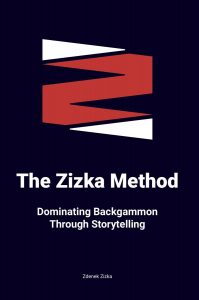 A great deal of backgammon wisdom takes the form of general principles, rules of thumb, or mathematical formulas for quantifying racing chances or solving cube decisions. But when none of your tools point confidently to a best play, what then? Zdenek Zizka’s “storytelling” method is an approach to reaching a conclusion by projecting “what rates to happen” in the ensuing exchange or two, often by breaking down your opponent’s immediate reply into subsets of useful or useless numbers. The informal tone of the writing won’t please everyone (and it’s riddled with typos), but it does capture the rough, over-the-board thought process the author is modeling. Zizka credits his youthful and meteoric rise in backgammon to his friend and teacher Mike “Falafel” Natanzon, who never published his methods, so we may be gaining some of them here.
A great deal of backgammon wisdom takes the form of general principles, rules of thumb, or mathematical formulas for quantifying racing chances or solving cube decisions. But when none of your tools point confidently to a best play, what then? Zdenek Zizka’s “storytelling” method is an approach to reaching a conclusion by projecting “what rates to happen” in the ensuing exchange or two, often by breaking down your opponent’s immediate reply into subsets of useful or useless numbers. The informal tone of the writing won’t please everyone (and it’s riddled with typos), but it does capture the rough, over-the-board thought process the author is modeling. Zizka credits his youthful and meteoric rise in backgammon to his friend and teacher Mike “Falafel” Natanzon, who never published his methods, so we may be gaining some of them here.
Backgammon Master Class (2023) - Marc Olsen & Masayuki Mochizuki
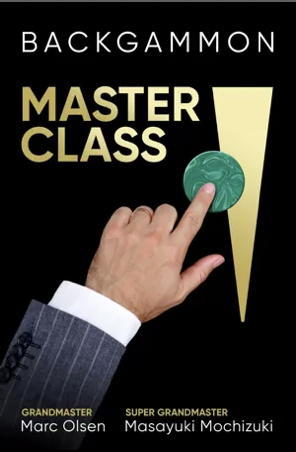 This book encapsulates the wisdom delivered by the authors in a four-part series of lectures at the 2021 UBC event in Marbella, Spain. Mochy’s opening section on “Strategic Visualization” and Marc’s follow-up on “Game Plan Dynamics” provide an accessible, immediately useful guide to understanding the fundamental backgammon game plans and acting upon them, a skill that provides an essential bridge from the Intermediate to the Advanced level of play. Having studied these sections, even advanced players will approach games with a new clarity of purpose that leads to more deliberate, accurate checker play. Mochy’s intervening section on “Backgame Strategy” provides a detailed anatomy of the various backgame configurations and how to get the most out of them. The final section, “Cube Action in Undefined Positions” by Marc, addresses the vast field of mid-game cube decisions that cannot be addressed by the many reliable reference positions available for well-defined opening blitzes, holding games, and bearoffs. The “Olsen Point System” evaluates such a position by assessing available threats and viable game plans in a simple formula. This section requires a far more advanced level of expertise to digest and apply effectively, as it relies upon a firm mastery of game-plan evaluations to begin with. As a result, these master classes taken in sequence should be highly effective in driving any reader’s PR in the right direction. The book is available in a handsome hardback and a more economical paperback version.
This book encapsulates the wisdom delivered by the authors in a four-part series of lectures at the 2021 UBC event in Marbella, Spain. Mochy’s opening section on “Strategic Visualization” and Marc’s follow-up on “Game Plan Dynamics” provide an accessible, immediately useful guide to understanding the fundamental backgammon game plans and acting upon them, a skill that provides an essential bridge from the Intermediate to the Advanced level of play. Having studied these sections, even advanced players will approach games with a new clarity of purpose that leads to more deliberate, accurate checker play. Mochy’s intervening section on “Backgame Strategy” provides a detailed anatomy of the various backgame configurations and how to get the most out of them. The final section, “Cube Action in Undefined Positions” by Marc, addresses the vast field of mid-game cube decisions that cannot be addressed by the many reliable reference positions available for well-defined opening blitzes, holding games, and bearoffs. The “Olsen Point System” evaluates such a position by assessing available threats and viable game plans in a simple formula. This section requires a far more advanced level of expertise to digest and apply effectively, as it relies upon a firm mastery of game-plan evaluations to begin with. As a result, these master classes taken in sequence should be highly effective in driving any reader’s PR in the right direction. The book is available in a handsome hardback and a more economical paperback version.
Problem Books
“Problem books” are compilations of illustrative backgammon positions, often organized into thematic chapters with introductory guidance laying out principles and tips for making proper checker and cube plays. This popular quizzing format simulates the decision-making process of real backgammon play, allowing the student to “learn by doing.”
Winning Backgammon - Problems & Answers (1930) - Grosvenor Nicholas & C. Wheaton Vaughan
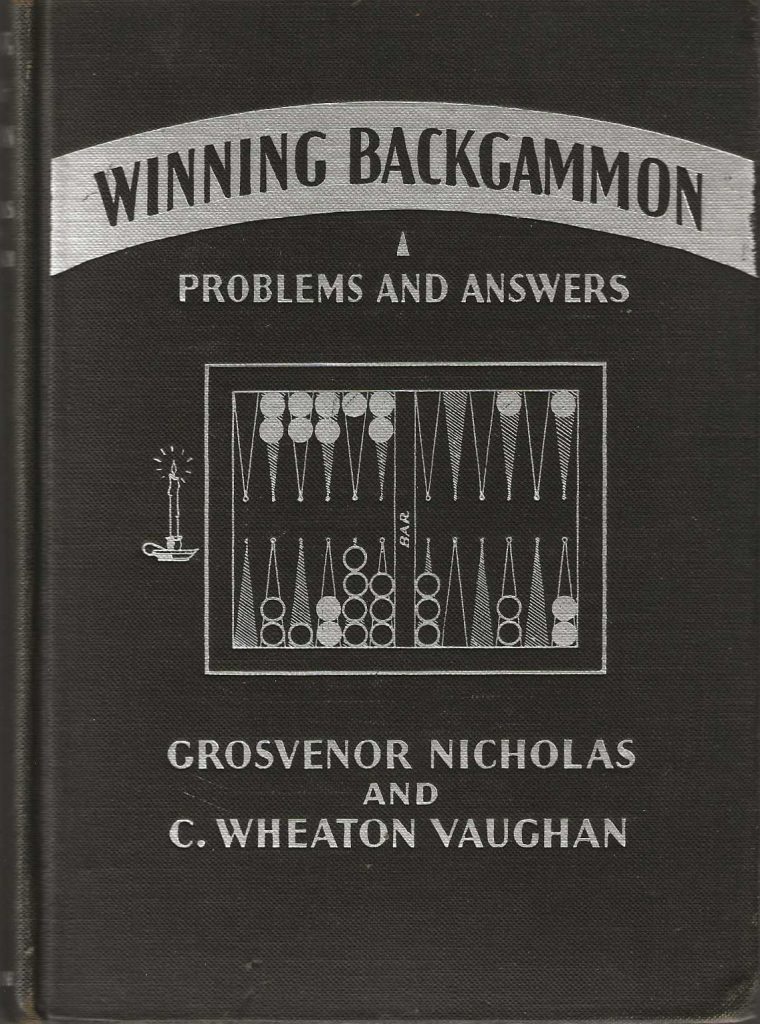
Included here primarily for its historical significance, Nicholas & Vaughan’s Winning backgammon is the game’s very first “problem book,” but it also deploys an instructional strategy that has not been attempted in any later book. Each of 23 chapters present a game scenario designed to exemplify sharply defined concepts (bearing off for safety, filling gaps . . . ). While such books have been commonplace since the 1970’s, none has taken Winning Backgammon‘s approach of offering multi-roll sequences to illustrate its concepts. Each “problem” specifies 5-9 rolls for the reader to play out properly, and then offers commentary on the entire exchange, showing the possible consequences of improper play. It’s a very effective approach that should help students familiarize themselves with patterns of play that recur frequently over the table, and is also a precursor to the match transcription commentaries that would appear decades later. Most of the illustrations are simple and direct, and there are some novelties such as a game where a dice complainer is awarded a 66 for each roll of an entire game.
The play notation and diagram layout is interesting in itself, with points numbered 1-6 by quadrant (Black Inner, White Outer, etc., so making your bar point would be BO6 to WO1, WO2 to WO1). And although each diagram includes a charming image of a candlestick to indicate the home board (according to the old tradition of playing in towards the light source), they did not think to illustrate cube position graphically, but rather stating “Black Doubled Last” to indicate who has the doubling privilege. This reflects the fact that at the time of writing, the doubling cube was less than a year old and doubling was still primarily a verbal act, with the stake indicated by matchsticks laid upon the bar. There was no clear marker for enjoying the doubling privilege! For a more thorough account of this book and others from this era, see the 1930’s Chronology.
Better Backgammon (1974) - Tim Holland
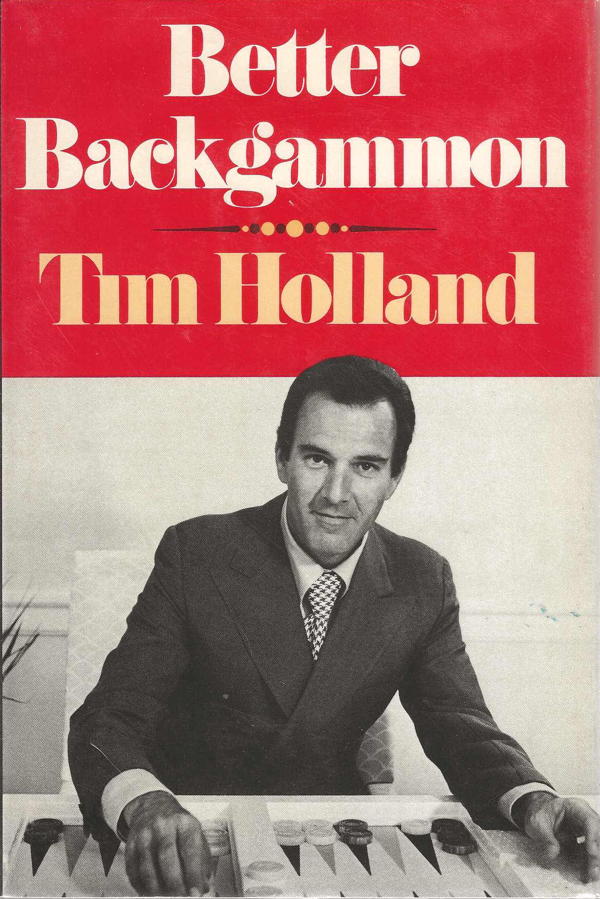
Tim Holland’s second book is a forgotten gem that holds up extremely well and fills a neglected gap in the field: it is a problem book aimed at the novice player who has learned the basic ropes of the game and is ready to start thinking like a real backgammoner. Virtually all of the problems in this book will be confidently solved by experienced intermediates, but most will be far from obvious to anyone who has not really studied the game. Holland introduces dice probabilities and basic doubling theory in a brisk, practical mode without making it sound any more difficult than it is. Though not divided into discrete chapters, the problems come in brief series that demonstrate the salient aspects of recurring situations — for example, bearing in against an ace-point anchor, or deciding whether to hit or not when playing a back game. Because Holland is so deliberate about the fundamental skills he is demonstrating, he rarely goes out on a limb trying to get too subtle and so his solutions with very few exceptions are borne out by XG evaluations. (Only Problems 18, 49, 55a and 61 are meaningfully wrong — and the worst of them is -.092 off.) Each problem seems to feature a little “eureka!” concept that will delight the novice reader and provide the sort of intellectual treats that make backgammon so much fun. (There’s even a nifty “banana split” play!)
On a minor technical note, it’s important to note that the Jacoby Rule is not in effect for this book. Holland does weigh gammon chances at times, but often he is clearly limiting the scope of his analysis to a particular point he is getting across to the novice rather than diving into deeper questions — so his analysis often applies best to a DMP scenario. There are also some unfortunate glitches in many of the graphics: some positions, including the very first problem, show too many checkers on the board, and several diagrams show checkers being put on the bar when they are meant to be borne off. They shouldn’t prove too confusing to the reader, but they are annoying and disappointing. Of course, this book is long out of print, but is well worth the hunt — and a perfect stepping-stone to Dwek’s Backgammon for Profit.
Backgammon For Profit (1975) - Joe Dwek
 Backgammon For Profit, written around the same time as Magriel’s Backgammon, could almost be regarded as an accompanying quiz book, inviting students of the game to build upon the broad conceptual knowledge provided by Magriel with a variety of more finely-tuned checker and cube problems. While modern backgammon software has found a fair number of Dwek’s solutions to be in error, this book can still be studied to great advantage, particularly if you annotate it with corrections discussed in Jeremy Bagai’s Classic Backgammon Revisited (listed elsewhere on this page).
Backgammon For Profit, written around the same time as Magriel’s Backgammon, could almost be regarded as an accompanying quiz book, inviting students of the game to build upon the broad conceptual knowledge provided by Magriel with a variety of more finely-tuned checker and cube problems. While modern backgammon software has found a fair number of Dwek’s solutions to be in error, this book can still be studied to great advantage, particularly if you annotate it with corrections discussed in Jeremy Bagai’s Classic Backgammon Revisited (listed elsewhere on this page).
Paradoxes and Probabilities (1978) - Barclay Cooke
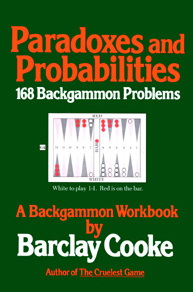 The most infamous of quiz books, Barclay Cooke’s Paradoxes and Probabilities exemplifies the 1970’s “pure style” of play, which emphasized making priming points in order, recirculating deeply-placed checkers at the expense of racing advantage, and too-willingly falling into back games. Rolling out all 168 positions for Classic Backgammon Revisited, Jeremy Bagai discovered that well over half of Cooke’s conclusions are contradicted by modern neural net programs, with a good third of them “badly wrong. ” So bring a curious but critical mind to this one — and keep Bagai’s book close at hand. Cooke’s writing is very persuasive, so this book could wreck your game if you’re not careful.
The most infamous of quiz books, Barclay Cooke’s Paradoxes and Probabilities exemplifies the 1970’s “pure style” of play, which emphasized making priming points in order, recirculating deeply-placed checkers at the expense of racing advantage, and too-willingly falling into back games. Rolling out all 168 positions for Classic Backgammon Revisited, Jeremy Bagai discovered that well over half of Cooke’s conclusions are contradicted by modern neural net programs, with a good third of them “badly wrong. ” So bring a curious but critical mind to this one — and keep Bagai’s book close at hand. Cooke’s writing is very persuasive, so this book could wreck your game if you’re not careful.
Advanced Backgammon (1991 revision) - Bill Robertie
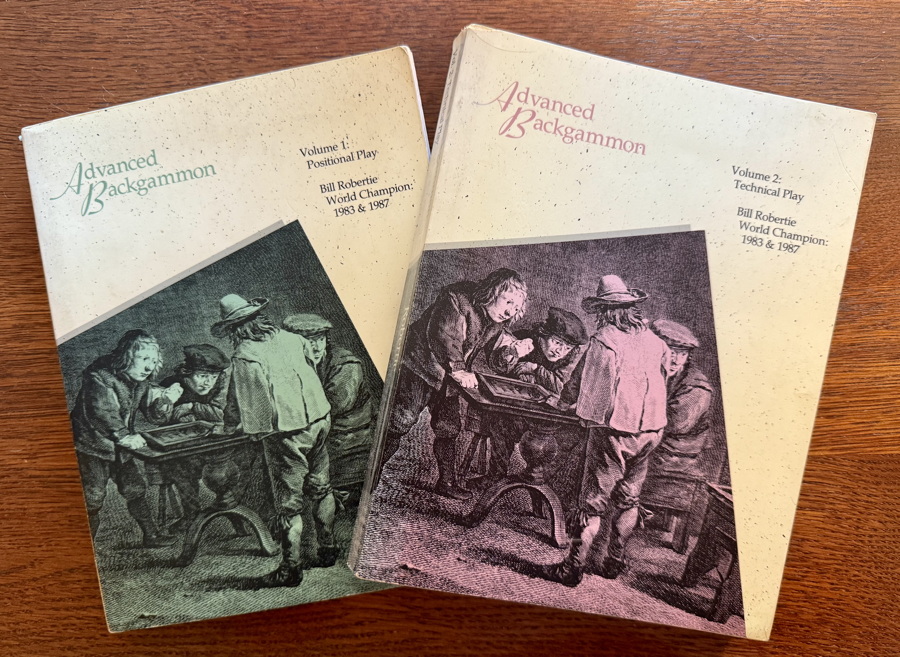 This two-volume work by Bill Robertie remains the most highly-regarded “problem book” in backgammon. Originally published in 1984 and often referred to as the “Blue Book”, the 1991 version is no mere re-print but a major revision, nearly doubling the original 241 positions to a total of 400 problems divided into two volumes. The first covers early/middle game “Positional” scenarios, while the second covers later-game “Technical” positions more amenable to mathematical analysis. Robertie revisited all the original positions, and deployed his rigorous practice of rolling out positions by hand on many of the positions. It’s remarkable that Jeremy Bagai lists only 28 positions the software program Snowie tagged as errors greater than .05 (Classic Backgammon Revisited). Unsurprisingly, only 6 of them come from the second, more technical volume, while the other 22 arise from the first volume, which Robertie characterizes as requiring more “intuition and creativity.” These books retain their instructional value because Robertie selects difficult positions that exemplify the core problem-solving techniques advanced players need to master in order to compete. Among the most enduringly useful is thinking in terms of “a cross section of 36 games” — for instance, trying to “find” nine wins (25% of 36) that will allow you to accept a cube in a volatile position.
This two-volume work by Bill Robertie remains the most highly-regarded “problem book” in backgammon. Originally published in 1984 and often referred to as the “Blue Book”, the 1991 version is no mere re-print but a major revision, nearly doubling the original 241 positions to a total of 400 problems divided into two volumes. The first covers early/middle game “Positional” scenarios, while the second covers later-game “Technical” positions more amenable to mathematical analysis. Robertie revisited all the original positions, and deployed his rigorous practice of rolling out positions by hand on many of the positions. It’s remarkable that Jeremy Bagai lists only 28 positions the software program Snowie tagged as errors greater than .05 (Classic Backgammon Revisited). Unsurprisingly, only 6 of them come from the second, more technical volume, while the other 22 arise from the first volume, which Robertie characterizes as requiring more “intuition and creativity.” These books retain their instructional value because Robertie selects difficult positions that exemplify the core problem-solving techniques advanced players need to master in order to compete. Among the most enduringly useful is thinking in terms of “a cross section of 36 games” — for instance, trying to “find” nine wins (25% of 36) that will allow you to accept a cube in a volatile position.
Fascinating Backgammon (1993) - Antonio Ortega
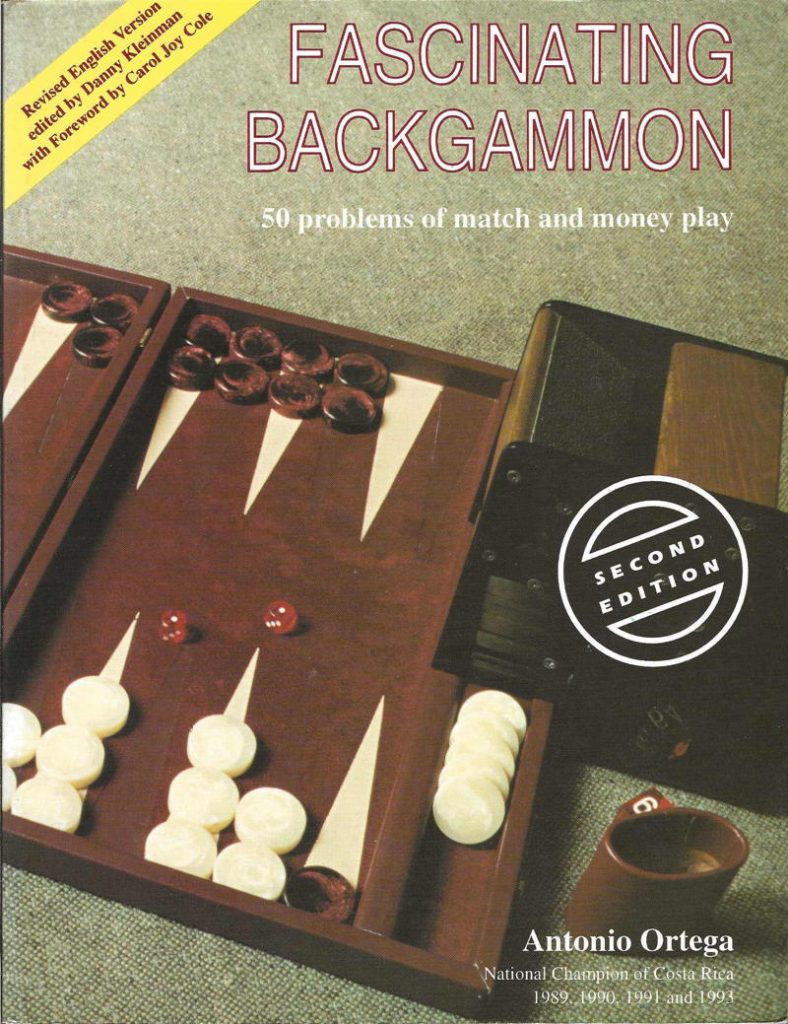 This is surely one of the most wide-ranging and mathematically rigorous problem books in the literature, but as such, it’s not the kind of book that reads well cover-to-cover. Rather, it should stand ready on your shelf for consultation when you have a particular need: Estimating Racing Chances; The Free Drop; Bearing off Against and Ace-Point Anchor; Redoubling after the Hit. These are all worthy topics, but reading it straight through is sort of like trying to sip water out of a gushing fire hydrant. Adding to the reading challenge is the intensely computational approach to solving problems. At the time of writing, bots were not in regular use to settle disagreements, and while some of the problems were rolled out with the very early Johnson & Weaver Expert Backgammon software, most of the argumentation here is of the brute-force calculation method, which makes for tedious reading for all but the most numerate students of the game. As a result, it can be difficult to extract generalized lessons from many of the positions. Perhaps in a gesture of mercy, the text is punctuated by whimsical sketches of a talking dice cup I like to call Cuppy.
This is surely one of the most wide-ranging and mathematically rigorous problem books in the literature, but as such, it’s not the kind of book that reads well cover-to-cover. Rather, it should stand ready on your shelf for consultation when you have a particular need: Estimating Racing Chances; The Free Drop; Bearing off Against and Ace-Point Anchor; Redoubling after the Hit. These are all worthy topics, but reading it straight through is sort of like trying to sip water out of a gushing fire hydrant. Adding to the reading challenge is the intensely computational approach to solving problems. At the time of writing, bots were not in regular use to settle disagreements, and while some of the problems were rolled out with the very early Johnson & Weaver Expert Backgammon software, most of the argumentation here is of the brute-force calculation method, which makes for tedious reading for all but the most numerate students of the game. As a result, it can be difficult to extract generalized lessons from many of the positions. Perhaps in a gesture of mercy, the text is punctuated by whimsical sketches of a talking dice cup I like to call Cuppy.
New Ideas in Backgammon (1996) - Kit Woolsey & Hal Heinrich
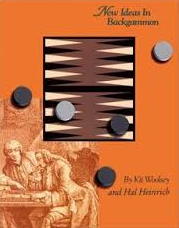 This very challenging problem book gathers 104 serious errors by world-class players in live tournament settings. All are checker-play problems, normalized for money play (so match score doesn’t come into it). It is the first backgammon text to make use of a neural net program, Jellyfish, to validate its conclusions, and the introduction provides a nice historical overview of bot capabilities and weaknesses at this early date. With the rollout data included for the top candidate plays, you can score your performance by the severity of your errors and calculate an average performance score for each of the thematic chapters, which point to perennially difficult game situations: “Anchors Aweigh,” “Pay Me Now or Pay Me Later,” “Scrambling Home” etc. And of course it’s Kit Woolsey, so the analysis is predictably lucid and compelling — and particularly thorough as he weighs each plausible candidate move in turn out loud.
This very challenging problem book gathers 104 serious errors by world-class players in live tournament settings. All are checker-play problems, normalized for money play (so match score doesn’t come into it). It is the first backgammon text to make use of a neural net program, Jellyfish, to validate its conclusions, and the introduction provides a nice historical overview of bot capabilities and weaknesses at this early date. With the rollout data included for the top candidate plays, you can score your performance by the severity of your errors and calculate an average performance score for each of the thematic chapters, which point to perennially difficult game situations: “Anchors Aweigh,” “Pay Me Now or Pay Me Later,” “Scrambling Home” etc. And of course it’s Kit Woolsey, so the analysis is predictably lucid and compelling — and particularly thorough as he weighs each plausible candidate move in turn out loud.
Understanding Backgammon (2003) - Kit Woolsey & Tami Jones
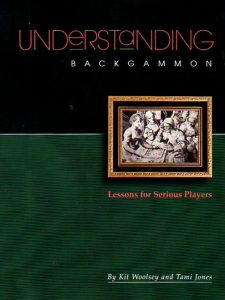 Where do backgammon writers get the positions for their books? Often, from their own high-quality matches, or by artificially setting them up to explore and validate sophisticated concepts. Understanding Backgammon will appeal to intermediate players because the problems are all genuine game positions that got the best of a genuine intermediate player, Tami Jones. The discussion of each problem comes in the form of a Socratic dialogue, with Kit Woolsey in the role of the philosopher bringing along his pupil — and the effect of hearing out the erroneous arguments in the course of arriving at the correct one is surprisingly effective, because we all need practice countering the bad arguments we form over the board (and cajoling our chouette partners into the right play). Woolsey is adept at making his arguments gently yet persuasively.
Where do backgammon writers get the positions for their books? Often, from their own high-quality matches, or by artificially setting them up to explore and validate sophisticated concepts. Understanding Backgammon will appeal to intermediate players because the problems are all genuine game positions that got the best of a genuine intermediate player, Tami Jones. The discussion of each problem comes in the form of a Socratic dialogue, with Kit Woolsey in the role of the philosopher bringing along his pupil — and the effect of hearing out the erroneous arguments in the course of arriving at the correct one is surprisingly effective, because we all need practice countering the bad arguments we form over the board (and cajoling our chouette partners into the right play). Woolsey is adept at making his arguments gently yet persuasively.
Classic Backgammon Revisited, 2nd edition (2005) - Jeremy Bagai
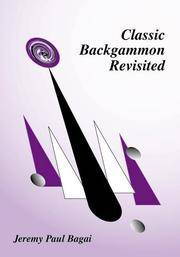 With the advent of strong backgammon-playing programs in the late 1990’s, it became possible to look back at the entire corpus of backgammon writing in fact-checking mode. Jeremy Bagai rose to the task, running rollout analysis on all the positions presented in five seminal texts: Jacoby & Crawford’s The Backgammon Book (1970), Dwek’s Backgammon for Profit, (1975), Magriel’s Backgammon (1976), Cooke’s Paradoxes and Probabilities (1978), and Robertie’s Advanced Backgammon (2nd edition, 1991). Far from simply second-guessing the original authors with the help of a tool they lacked, Bagai proves himself worthy to be in their company with subtle analyses of how, and perhaps why, 120 of their problem solutions now appear to have been substantially incorrect.
With the advent of strong backgammon-playing programs in the late 1990’s, it became possible to look back at the entire corpus of backgammon writing in fact-checking mode. Jeremy Bagai rose to the task, running rollout analysis on all the positions presented in five seminal texts: Jacoby & Crawford’s The Backgammon Book (1970), Dwek’s Backgammon for Profit, (1975), Magriel’s Backgammon (1976), Cooke’s Paradoxes and Probabilities (1978), and Robertie’s Advanced Backgammon (2nd edition, 1991). Far from simply second-guessing the original authors with the help of a tool they lacked, Bagai proves himself worthy to be in their company with subtle analyses of how, and perhaps why, 120 of their problem solutions now appear to have been substantially incorrect.
In making this monumental effort, Bagai has also helped to rejuvenate these five excellent books, providing a means to study and enjoy them with confidence.
What Colour is the Wind? (1998-2001, revised 2015), - Chris Bray
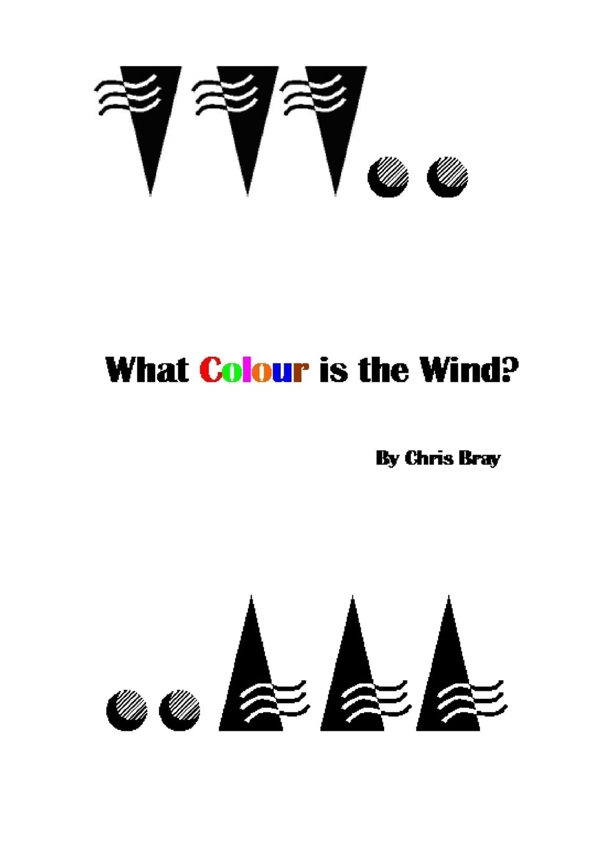 Chris Bray’s bountiful collection of positions and short historical reflections were drawn mostly from his weekly backgammon feature in the Saturday Independent newspaper in England. As such, this problem book is designed to be accessible to a very broad range of readers and succeeds admirably. The solutions to some positions will be obvious to a solid intermediate, and others will challenge experts — but the analysis will be readily understandable to every reader with a fundamental grasp of game rules and a familiarity with the critical vocabulary of the game. At 245 pages, the book contains perhaps 180-200 problems as well as reflections on the development of backgammon computer programs, new trends in playing traditions (I love the article on ‘Prop Chouettes’), and intriguing historical discoveries like the 1930’s “doubling dial” he found on eBay. Bray’s 2015 revision to his writings is substantial, as all of the problems were run past XG and he modified positions or commentary to meet current standards of analysis.
Chris Bray’s bountiful collection of positions and short historical reflections were drawn mostly from his weekly backgammon feature in the Saturday Independent newspaper in England. As such, this problem book is designed to be accessible to a very broad range of readers and succeeds admirably. The solutions to some positions will be obvious to a solid intermediate, and others will challenge experts — but the analysis will be readily understandable to every reader with a fundamental grasp of game rules and a familiarity with the critical vocabulary of the game. At 245 pages, the book contains perhaps 180-200 problems as well as reflections on the development of backgammon computer programs, new trends in playing traditions (I love the article on ‘Prop Chouettes’), and intriguing historical discoveries like the 1930’s “doubling dial” he found on eBay. Bray’s 2015 revision to his writings is substantial, as all of the problems were run past XG and he modified positions or commentary to meet current standards of analysis.
What's Your Game Plan? (2011) - Mary Hickey & Marty Storer
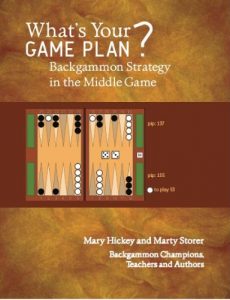 Most backgammon books take a thematic approach to organizing their lessons and example positions. After all, the point isn’t to learn what to do in a specific, unique position — it’s to master principles of play that we can apply to frequently arising “kinds” of situations, right? Well, yes, but somehow backgammon doesn’t always cooperate, serving up problems that yield placidly to general principles. In What’s Your Game Plan? Hickey and Storer serve up 122 gnarly checker-play problems arising from the difficult middle-game phase, and walk you through the thought processes that world-class players use to arrive at the right answer. Many of the problems arise from crucial inflection points in a game, when rival plays lead to substantially different approaches to winning — hence the title. In addition to all the analytical practice, readers will come away from the book with an invaluable over-arching habit: actively thinking about and choosing among the viable game plans available to you, rather than playing backgammon as a series of disconnected quiz problems.
Most backgammon books take a thematic approach to organizing their lessons and example positions. After all, the point isn’t to learn what to do in a specific, unique position — it’s to master principles of play that we can apply to frequently arising “kinds” of situations, right? Well, yes, but somehow backgammon doesn’t always cooperate, serving up problems that yield placidly to general principles. In What’s Your Game Plan? Hickey and Storer serve up 122 gnarly checker-play problems arising from the difficult middle-game phase, and walk you through the thought processes that world-class players use to arrive at the right answer. Many of the problems arise from crucial inflection points in a game, when rival plays lead to substantially different approaches to winning — hence the title. In addition to all the analytical practice, readers will come away from the book with an invaluable over-arching habit: actively thinking about and choosing among the viable game plans available to you, rather than playing backgammon as a series of disconnected quiz problems.
501 Essential Backgammon Problems (2019, 3rd edition) - Bill Robertie
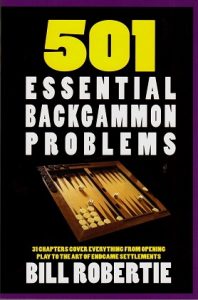 In 31 quiz-format chapters, Bill Robertie offers up 501 highly relevant backgammon problems that encompass most of the frequently-recurring situations that arise in competitive play. The first 12 chapters are best read in sequence, establishing the major patterns and essential elements of backgammon, but thereafter you won’t be able to resist navigating at will among the 19 other sharply-defined topics, targeting the ones you struggle with most: “Action Doubles,” “Breaking Anchor,” and “Post-Ace-Point Games” among them.
In 31 quiz-format chapters, Bill Robertie offers up 501 highly relevant backgammon problems that encompass most of the frequently-recurring situations that arise in competitive play. The first 12 chapters are best read in sequence, establishing the major patterns and essential elements of backgammon, but thereafter you won’t be able to resist navigating at will among the 19 other sharply-defined topics, targeting the ones you struggle with most: “Action Doubles,” “Breaking Anchor,” and “Post-Ace-Point Games” among them.
Backgammon Super Genius Quiz (2022) - James Vogl
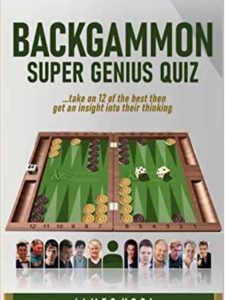 James Vogl hit upon a brilliant strategy for a book: assemble a slate of a dozen world-respected backgammon greats (including former Harvard Square BG denizen David Wells!) and have them vie for a $5000 prize by quizzing them on 100 super-tough positions he had gotten wrong over the board. Then present the same 10-section quiz to readers accompanied by pithy, focused commentary from the contestants and summaries of what can be learned from each topical set of 10 problems. The resulting book is incredibly engaging, as the reader is invited to self-score and compare their results to the running totals of the “super geniuses.” The book is full of memorable, useful “rules of thumb” and approaches to problem solving the reader can readily deploy over the board. While the graphics of the book have been lamented in some quarters (board diagrams are stretched screen shots of XG windows, making it hard to read the equity figures), the practical content and entertainment value of the book are easily worth the price of this softcover book.
James Vogl hit upon a brilliant strategy for a book: assemble a slate of a dozen world-respected backgammon greats (including former Harvard Square BG denizen David Wells!) and have them vie for a $5000 prize by quizzing them on 100 super-tough positions he had gotten wrong over the board. Then present the same 10-section quiz to readers accompanied by pithy, focused commentary from the contestants and summaries of what can be learned from each topical set of 10 problems. The resulting book is incredibly engaging, as the reader is invited to self-score and compare their results to the running totals of the “super geniuses.” The book is full of memorable, useful “rules of thumb” and approaches to problem solving the reader can readily deploy over the board. While the graphics of the book have been lamented in some quarters (board diagrams are stretched screen shots of XG windows, making it hard to read the equity figures), the practical content and entertainment value of the book are easily worth the price of this softcover book.
Opening & Early Game
Ever feel like you wind up on the defensive in more than your share of backgammon games? Maybe your opening play needs work. Since every game has an opening, giving away even small amounts of equity with inaccurate replies and faulty deployment of your checkers can lead to putting you back on your heels more often than necessary, and missing out on your share of early attack cubes. Long neglected in the backgammon literature, the opening is finally getting its due.
Backgammon Openings: Book A (2007) - Nack Ballard & Paul Weaver
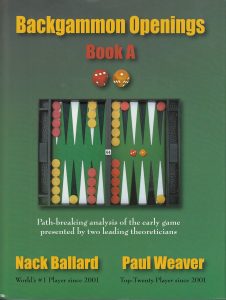 This meticulous work of backgammon scholarship was made possible by the advent of strong computer-rollout programs and the dogged brilliance of both authors, who devote this entire volume to the proper playing of 3-1 in the first three exchanges of a backgammon game. The virtues and risks of various hitting, pointing and slotting options are weighed in each position, and similar positions are juxtaposed to help the reader form a deep understanding of the relative weight of different factors. Some students of the game will grow impatient with the narrow focus of this book; however, mastery of the dynamics of these early 3-1 plays should translate into superior early-game play in general. While further volumes had been planned (and eagerly anticipated), there is, alas, no Book B.
This meticulous work of backgammon scholarship was made possible by the advent of strong computer-rollout programs and the dogged brilliance of both authors, who devote this entire volume to the proper playing of 3-1 in the first three exchanges of a backgammon game. The virtues and risks of various hitting, pointing and slotting options are weighed in each position, and similar positions are juxtaposed to help the reader form a deep understanding of the relative weight of different factors. Some students of the game will grow impatient with the narrow focus of this book; however, mastery of the dynamics of these early 3-1 plays should translate into superior early-game play in general. While further volumes had been planned (and eagerly anticipated), there is, alas, no Book B.
Opening Concepts (2017) - Michihito Kageyama & Roland Herrera
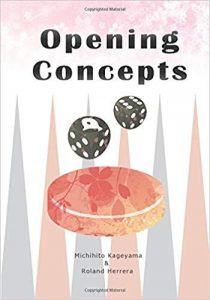 Michihito Kageyama’s Opening Concepts has been almost euphorically greeted by the backgammon community — at least among players who had not already achieved expertise in this area. Michy builds our understanding through a series of “proverbs” that express generally desirable actions or guide play in specific situations. Phrases like “Break the Mountain” (for “unstack”) and “Double Tiger” (hit twice in home board, leaving two blots) have already entered the popular backgammon vocabulary. Although the book is less effective in helping the player weigh multiple factors that point in different directions, it is one that can do the beginning and intermediate player a whole lot of good in a short amount of time. The lessons are enlivened by Roland Herrera’s fanciful illustrations of “Nono,” which you’ll find delightful or annoying depending on your tolerance for puns and cute-factor. But if Nono is your idea of a deal-breaker you may need to lighten up.
Michihito Kageyama’s Opening Concepts has been almost euphorically greeted by the backgammon community — at least among players who had not already achieved expertise in this area. Michy builds our understanding through a series of “proverbs” that express generally desirable actions or guide play in specific situations. Phrases like “Break the Mountain” (for “unstack”) and “Double Tiger” (hit twice in home board, leaving two blots) have already entered the popular backgammon vocabulary. Although the book is less effective in helping the player weigh multiple factors that point in different directions, it is one that can do the beginning and intermediate player a whole lot of good in a short amount of time. The lessons are enlivened by Roland Herrera’s fanciful illustrations of “Nono,” which you’ll find delightful or annoying depending on your tolerance for puns and cute-factor. But if Nono is your idea of a deal-breaker you may need to lighten up.
How To Play the Opening in Backgammon, Parts 1, 2, and 3 (2020-22) - Bill Robertie
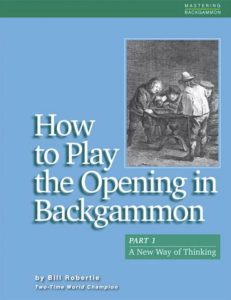
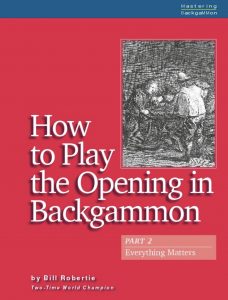
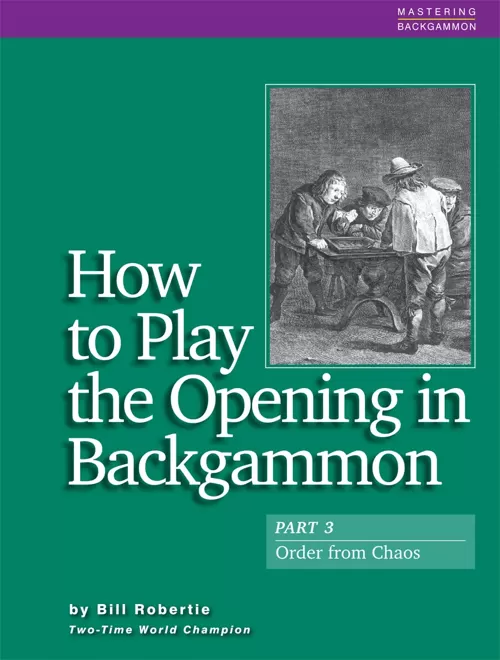 Here at last is a thorough treatment of the opening few exchanges in backgammon. While you probably already know the best opening plays and perhaps even the replies, Robertie offers a fresh take on how the various options compare in terms of assets and liabilities, while also providing intriguing historical notes on how professional practice evolved over the past century. And rather than pursuing the usual “rules & exceptions” approach to the opening replies, Robertie conveys the logic behind the most common default plays while also finding the common elements in smaller subsets of more difficult positions. The 3rd volume covers uncharted territory, looking closely at the utility of checkers run into the opponent’s outfield, and under-appreciated opportunities for doubling in the early game.
Here at last is a thorough treatment of the opening few exchanges in backgammon. While you probably already know the best opening plays and perhaps even the replies, Robertie offers a fresh take on how the various options compare in terms of assets and liabilities, while also providing intriguing historical notes on how professional practice evolved over the past century. And rather than pursuing the usual “rules & exceptions” approach to the opening replies, Robertie conveys the logic behind the most common default plays while also finding the common elements in smaller subsets of more difficult positions. The 3rd volume covers uncharted territory, looking closely at the utility of checkers run into the opponent’s outfield, and under-appreciated opportunities for doubling in the early game.
Topics in Checker Play
Once you have read some general treatments of backgammon strategy and have grown experienced enough to identify the weak spots in your game — those recurring situations that leave you baffled — it makes sense to seek out some of these more tightly-focused books. Books in this section either treat a limited situational topic, or devote themselves to particular concepts and tools useful in improving your checker play.
Modern Backgammon (2001) - Bill Robertie
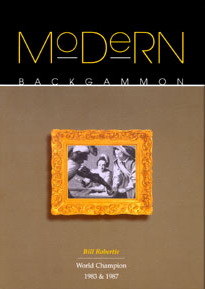 Modern Backgammon might seem like a generic title, but it’s not. At the time of writing, the backgammon world was getting roundly schooled by upstart neural net computer programs that were suddenly beating the best human players — but the ‘bots weren’t telling how. What was needed was a master theorist who could study robotic play and translate its often baffling choices into accessible principles humans could apply over the board. Bill Robertie does just that, offering four new conceptual arrows for our quiver: Efficiency, Connectivity, Non-Commitment, and Robustness. In a perverse twist, a later, even stronger program (eXtreme Gammon – ‘XG’) would overturn some of these earlier bot decisions — particularly in the chapter on “Robustness,” but these four concepts are here to stay. (For a guide to XG’s “corrections” of the text, see this analysis by Randy Pals.)
Modern Backgammon might seem like a generic title, but it’s not. At the time of writing, the backgammon world was getting roundly schooled by upstart neural net computer programs that were suddenly beating the best human players — but the ‘bots weren’t telling how. What was needed was a master theorist who could study robotic play and translate its often baffling choices into accessible principles humans could apply over the board. Bill Robertie does just that, offering four new conceptual arrows for our quiver: Efficiency, Connectivity, Non-Commitment, and Robustness. In a perverse twist, a later, even stronger program (eXtreme Gammon – ‘XG’) would overturn some of these earlier bot decisions — particularly in the chapter on “Robustness,” but these four concepts are here to stay. (For a guide to XG’s “corrections” of the text, see this analysis by Randy Pals.)
Backgammon Problems (2007) - Mike Corbett
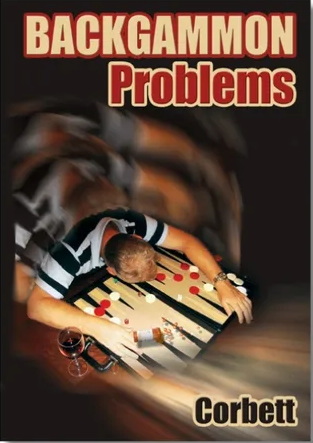 While this book initially seemed like it would belong in the general “problem book” section, Mike Corbett’s focus is almost exclusively on late-game checker plays, with occasional cube decisions added to the mix when they highlight the effect of checker plays that follow. Corbett’s mission isn’t primarily about identifying principles and rules of thumb to guide play (although the careful reader should extract many of these), but to illuminate the kinds of situations where Snowie, the dominant ‘bot of its day, falls down in its 3-ply evaluations. Corbett sets Snowie the task of thinking harder, showing how its deeper rollouts sharply reverse the quicker evaluations. Plugging a few of the positions into XG suggests that XG on a quick + level or even 3-ply evaluation generally agrees with Snowie’s rollouts, suggesting that (1) Corbett’s insights about Snowie’s 3-ply limitations were on target, and (2) that the conclusions Corbett draws about proper play in these challenging late-game positions remain valid. But the reader needn’t dwell on the subtleties of these ‘bot wars and equity figures — Corbett’s extravagant writing, full of offbeat metaphors, colorful analogies and historical references, makes for a highly entertaining read.
While this book initially seemed like it would belong in the general “problem book” section, Mike Corbett’s focus is almost exclusively on late-game checker plays, with occasional cube decisions added to the mix when they highlight the effect of checker plays that follow. Corbett’s mission isn’t primarily about identifying principles and rules of thumb to guide play (although the careful reader should extract many of these), but to illuminate the kinds of situations where Snowie, the dominant ‘bot of its day, falls down in its 3-ply evaluations. Corbett sets Snowie the task of thinking harder, showing how its deeper rollouts sharply reverse the quicker evaluations. Plugging a few of the positions into XG suggests that XG on a quick + level or even 3-ply evaluation generally agrees with Snowie’s rollouts, suggesting that (1) Corbett’s insights about Snowie’s 3-ply limitations were on target, and (2) that the conclusions Corbett draws about proper play in these challenging late-game positions remain valid. But the reader needn’t dwell on the subtleties of these ‘bot wars and equity figures — Corbett’s extravagant writing, full of offbeat metaphors, colorful analogies and historical references, makes for a highly entertaining read.
Playing Doublets (2013) - Ongun Alsaç & Güray Alsaç
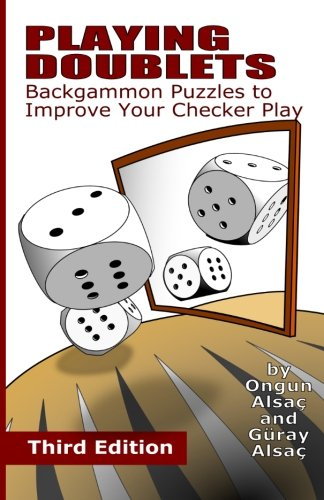 While generally a welcome sight, doublets can be notoriously difficult to play properly. The basic reason is that you have twice as many checkers to move, so you have a much larger set of candidates to choose from. A second reason is that doublets move so much material that they can encourage a change in game plan, and failing to change your game plan appropriately will usually be a blunder. A third challenge is our tendency to see doublets moving in pairs of checkers, and our difficulty in immediately spotting long-range plays like using, say, three 4’s to hit a blot on our 10-point with a checker way back on our 22 — so we just miss good stuff if we aren’t methodical enough.
While generally a welcome sight, doublets can be notoriously difficult to play properly. The basic reason is that you have twice as many checkers to move, so you have a much larger set of candidates to choose from. A second reason is that doublets move so much material that they can encourage a change in game plan, and failing to change your game plan appropriately will usually be a blunder. A third challenge is our tendency to see doublets moving in pairs of checkers, and our difficulty in immediately spotting long-range plays like using, say, three 4’s to hit a blot on our 10-point with a checker way back on our 22 — so we just miss good stuff if we aren’t methodical enough.
This book offers a workout in playing doublets, with a chapter of 30 problems devoted to each species (in the Alsaç lingo, snake eyes, ducks, amigos, quads, girls and boys). The positions are drawn from major championship matches among prominent players and feature brief historical annotations, so you can draw some comfort seeing that Mochy or Kaz got it wrong too. Beyond some very general pointers about trying to do two good things rather than one great thing, attributed to Walter Trice, the book offers little guidance in decision-making, so you’ll have to treat the book as raw material for figuring out the patterns and processes for playing doublets largely on your own. Perhaps there’s still book to be written on this topic, systematically approaching the unique behaviors of the six doublets? For now, this collection of 180 problems is a fertile ground for exploration.
Endgame Technique (2019) - Michihito Kageyama & Roland Herrera
 Michy Kageyama’s followup to his popular Opening Concepts (1917) fills a conspicuous gap in the backgammon literature. Nowhere else have we seen the routine mechanics of late-game checker play scenarios treated in such meticulous detail — which is a little surprising, given how frequently these situations arise. How do you bear off checkers against an ace-point anchor in order to minimize your chances of leaving a blot? How about a deuce-point anchor? How do you bear in checkers to your home-board and then bear them off most efficiently in a simple race? How do you decide when to break your deep anchor, or split your checkers, when you are desperate to induce a game-saving blot against your opponent’s bear-off? Even expert players who think they know all about these topics will discover surprising and subtle techniques to help squeeze every bit of equity out of the final phases of the game.
Michy Kageyama’s followup to his popular Opening Concepts (1917) fills a conspicuous gap in the backgammon literature. Nowhere else have we seen the routine mechanics of late-game checker play scenarios treated in such meticulous detail — which is a little surprising, given how frequently these situations arise. How do you bear off checkers against an ace-point anchor in order to minimize your chances of leaving a blot? How about a deuce-point anchor? How do you bear in checkers to your home-board and then bear them off most efficiently in a simple race? How do you decide when to break your deep anchor, or split your checkers, when you are desperate to induce a game-saving blot against your opponent’s bear-off? Even expert players who think they know all about these topics will discover surprising and subtle techniques to help squeeze every bit of equity out of the final phases of the game.
Back Checker Strategy (2021) - Michihito Kageyama & Roland Herrera
 The third in Michy Kageyama’s Backgammon Odyssey series of thematic studies addresses proper handling of checkers straggling in your opponent’s home board. Until you’ve successfully escaped both your back men, decisions about whether to split, or to run, or to give up a precious anchor in order to hit a blot are a nearly constant challenge, and Michy usefully characterizes back checker strategy into five distinct “phases” (though “scenarios” might have been a better term), elucidating useful precepts for handling common choices that arise in each. And as always, Michy employs colorful metaphors (“Butterfly Anchor,” “Glued Checkers”) to help his proverbial advice lodge in your memory.
The third in Michy Kageyama’s Backgammon Odyssey series of thematic studies addresses proper handling of checkers straggling in your opponent’s home board. Until you’ve successfully escaped both your back men, decisions about whether to split, or to run, or to give up a precious anchor in order to hit a blot are a nearly constant challenge, and Michy usefully characterizes back checker strategy into five distinct “phases” (though “scenarios” might have been a better term), elucidating useful precepts for handling common choices that arise in each. And as always, Michy employs colorful metaphors (“Butterfly Anchor,” “Glued Checkers”) to help his proverbial advice lodge in your memory.
Backgammon: Strategic Concepts (2023) - François Tardieu
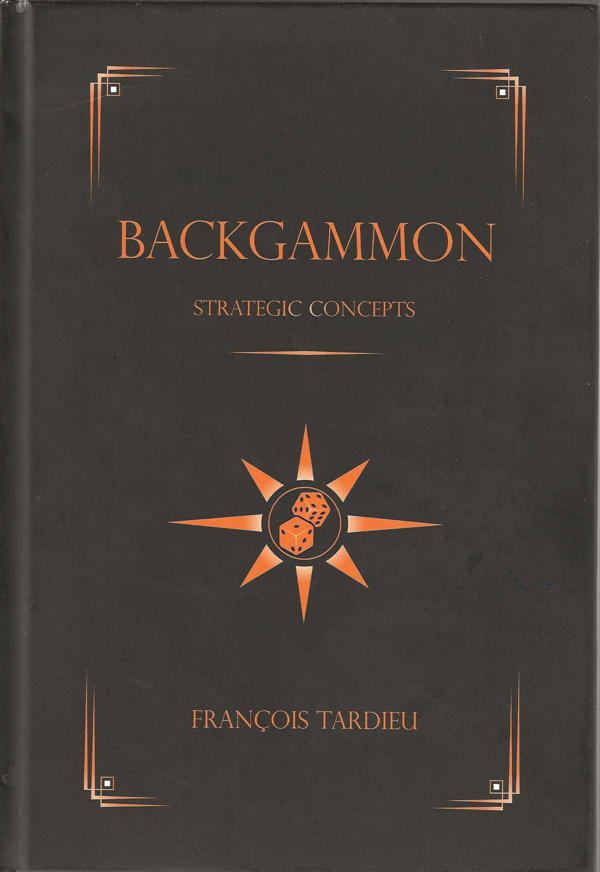 Rather than attempt exhaustive coverage of all aspects of backgammon, this superb text addresses seven specific situations that recur frequently in any backgammon session and which pose some of the greatest challenges to players of any level. Chapter 2: Should you leave your advanced anchor? and Chapter 6: Pay now or pay later? are among the most frequently vexing decisions in backgammon. Chapter 4 is devoted to Blitzing technique and 5 lays out the dynamics of Prime vs. Prime positions. Each chapter offers pertinent examples and draws out pithy, practical aphorisms to guide play. This is the type of backgammon book that is best studied in sections — just pick the topic that gives you the most trouble, study and absorb Tardieu’s guidance, and then look forward to encountering these scenarios in your next match! What’s more, unlike so many self-published backgammon texts of late, the prose is eloquent, effortlessly conveying subtle ideas, and the book design is excellent, with clear graphics and minimal little dead space. The positional analysis is always in close proximity to the relevant positional diagrams, and Tardieu keeps the equity figures to a useful minimum. This is 316 pages of pure content, all of it accessible to intermediate and world-class players alike.
Rather than attempt exhaustive coverage of all aspects of backgammon, this superb text addresses seven specific situations that recur frequently in any backgammon session and which pose some of the greatest challenges to players of any level. Chapter 2: Should you leave your advanced anchor? and Chapter 6: Pay now or pay later? are among the most frequently vexing decisions in backgammon. Chapter 4 is devoted to Blitzing technique and 5 lays out the dynamics of Prime vs. Prime positions. Each chapter offers pertinent examples and draws out pithy, practical aphorisms to guide play. This is the type of backgammon book that is best studied in sections — just pick the topic that gives you the most trouble, study and absorb Tardieu’s guidance, and then look forward to encountering these scenarios in your next match! What’s more, unlike so many self-published backgammon texts of late, the prose is eloquent, effortlessly conveying subtle ideas, and the book design is excellent, with clear graphics and minimal little dead space. The positional analysis is always in close proximity to the relevant positional diagrams, and Tardieu keeps the equity figures to a useful minimum. This is 316 pages of pure content, all of it accessible to intermediate and world-class players alike.
To Hit or Not to Hit, Vol. I (2024) - Dirk Schiemann
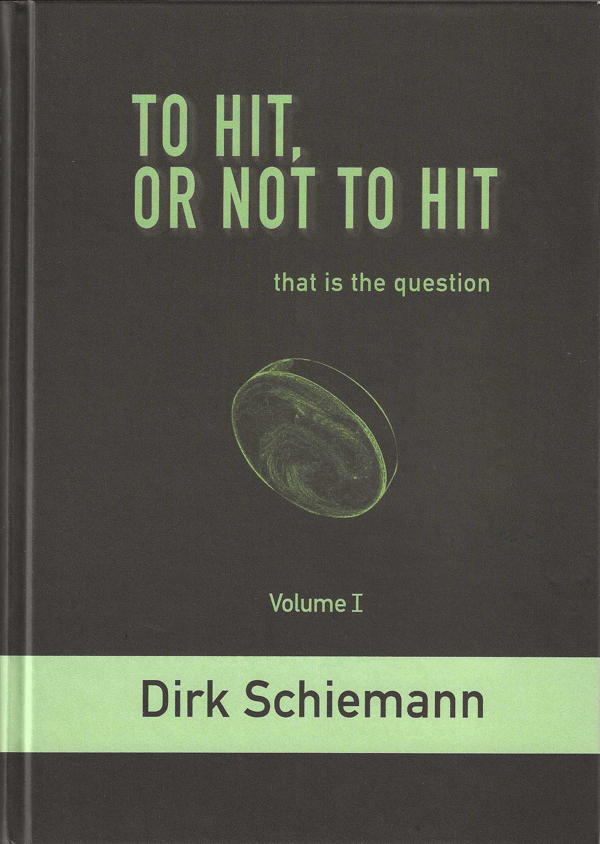 Dirk Schiemann has followed up the magisterial Theory of Backgammon (2021) with a very deep dive into a single aspect of the game: the theory of blot-hitting. As with his previous tome, his approach is methodical and thorough, identifying and exploring the various motivations and benefits of hitting checkers across the full range of game scenarios where the option might present itself. Hitting in the inner board and hitting in the outer board are treated in separate sections, and within each he pits the hitting option against some other attractive alternative, a useful approach also favored by Bill Robertie in his trilogy of books on How to Play the Opening in Backgammon. This book covers situations in the early and mid-game, while a promised second volume will address sharply-defined game types such as blitzes and back games. Once again Schiemann has taken pains to deliver a handsome book, with meticulously edited prose and professional diagramming, typography and page layout.
Dirk Schiemann has followed up the magisterial Theory of Backgammon (2021) with a very deep dive into a single aspect of the game: the theory of blot-hitting. As with his previous tome, his approach is methodical and thorough, identifying and exploring the various motivations and benefits of hitting checkers across the full range of game scenarios where the option might present itself. Hitting in the inner board and hitting in the outer board are treated in separate sections, and within each he pits the hitting option against some other attractive alternative, a useful approach also favored by Bill Robertie in his trilogy of books on How to Play the Opening in Backgammon. This book covers situations in the early and mid-game, while a promised second volume will address sharply-defined game types such as blitzes and back games. Once again Schiemann has taken pains to deliver a handsome book, with meticulously edited prose and professional diagramming, typography and page layout.
The Golden Point (2025) - Marc Olsen
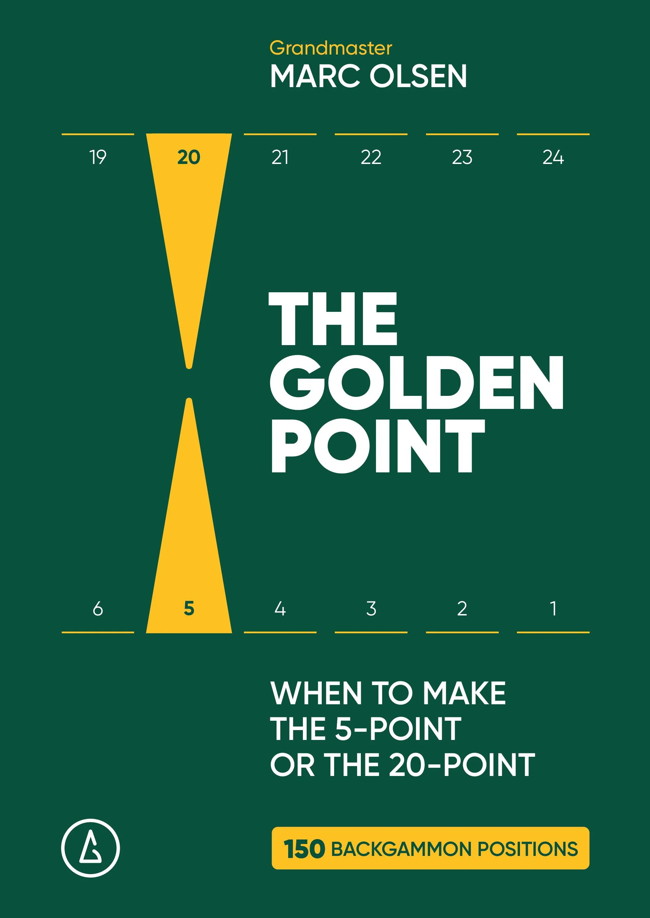 Conventional wisdom says that good rolls are easier to play — but what if you have two great options? Olsen chooses a superb focus for this collection of 150 surprisingly difficult positions inviting us to weigh the sharply contrasting benefits of making your best priming point or a high anchor that will tend to frustrate your opponent’s offense. We’re offered a basket of considerations (checker distribution, racing/timing advantages, back checker status) in a brief introductory section and then let loose on a series of fifteen 10-problem quizzes. The problems are carefully sequenced in order to illustrate the effects of subtle changes in position, but one might wish that Olsen had taken a more traditional approach grouping problems under persistent themes and discussing their dynamics at length — such as the “compounding effects of structure,” or determining when we can afford not to anchor against a blitzing position, etc. At times, the “Although A is admittedly very important, we simply get more value from B” structure of positional analysis can be frustrating, as the argument could simply be flipped if XG had come out with the opposite solution. The “quizzing” format too, would be much more engaging and meaningful with a scoring system that tallied the equity lost through bad choices (a kind of Quiz PR) — rather than counting a wrong answer the same whether a small error or a double blunder — and presenting each quiz as equally difficult. (It might have been interesting to order the quizzes by difficulty / subtlety!) On the whole, the book provides an enormously valuable collection of challenging positions on a focused theme, accompanied by wealth of useful concepts and factors to weigh in approaching them over the board. The reader just needs to work at extracting reliable, memorable tools from the myriad examples.
Conventional wisdom says that good rolls are easier to play — but what if you have two great options? Olsen chooses a superb focus for this collection of 150 surprisingly difficult positions inviting us to weigh the sharply contrasting benefits of making your best priming point or a high anchor that will tend to frustrate your opponent’s offense. We’re offered a basket of considerations (checker distribution, racing/timing advantages, back checker status) in a brief introductory section and then let loose on a series of fifteen 10-problem quizzes. The problems are carefully sequenced in order to illustrate the effects of subtle changes in position, but one might wish that Olsen had taken a more traditional approach grouping problems under persistent themes and discussing their dynamics at length — such as the “compounding effects of structure,” or determining when we can afford not to anchor against a blitzing position, etc. At times, the “Although A is admittedly very important, we simply get more value from B” structure of positional analysis can be frustrating, as the argument could simply be flipped if XG had come out with the opposite solution. The “quizzing” format too, would be much more engaging and meaningful with a scoring system that tallied the equity lost through bad choices (a kind of Quiz PR) — rather than counting a wrong answer the same whether a small error or a double blunder — and presenting each quiz as equally difficult. (It might have been interesting to order the quizzes by difficulty / subtlety!) On the whole, the book provides an enormously valuable collection of challenging positions on a focused theme, accompanied by wealth of useful concepts and factors to weigh in approaching them over the board. The reader just needs to work at extracting reliable, memorable tools from the myriad examples.
Doubling
Skillful use of the doubling cube is difficult to teach because doubling depends upon a thorough familiarity with not only the various game plans, but also their likelihood of success. And this requires a certain amount of playing experience. Before investing time in books on this topic, students of the game should be well-versed in the analytic vocabulary of backgammon checker play, and be prepared to master skills such as “counting shots” (the probability of achieving certain aims on your next roll of the dice) and pip-counting (if you intend to compete in ‘live’ games).
Winning With the Doubling Cube (1997) - Peter Bell
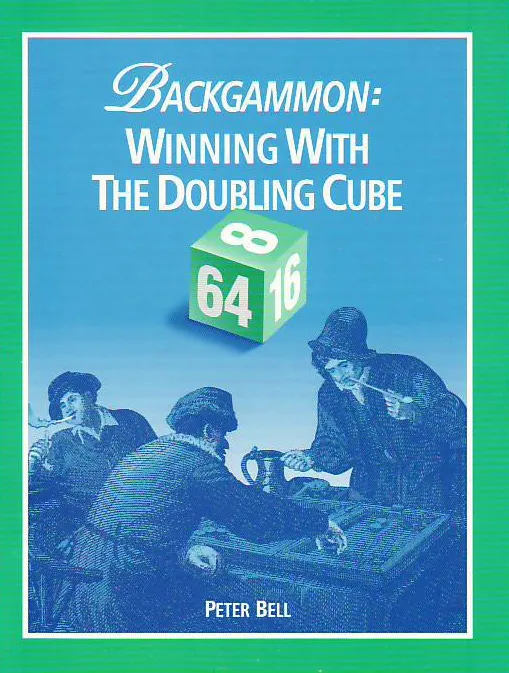 It’s a shame that this isn’t a better book than it is, because it offers one of the most methodical introductions to the whole range of doubling concepts needed by the novice doubler, including a nice primer on dice probabilities, and a great deal of practical advice for the aspiring money-game and chouette player. But when it comes to specifics, the book falls down badly. Many of the recommended cube actions are just spectacularly wrong, on the order of .350 triple-blunders. One prime vs. prime position he deems “Too Good” is actually a beaver (Diagram 63). He reaches these faulty conclusions by relying on a series of misguided heuristic tools for “Common Types of Games” (Blitz Count, Timing Count, Priming and Back Game ‘Tables’ etc.). These methods were clearly not given enough vetting, as a quick run-through with the Jellyfish software available at the time would have shown. On a less damaging side note, much of Bell’s terminology is quaintly idiosyncratic — “Cashers” for “Market Losers” and doubling “Pane” rather than “Window” are actually decent substitutes (though “Cash Crasher” for getting your marker back after playing on for the gammon is maybe a bridge too far).
It’s a shame that this isn’t a better book than it is, because it offers one of the most methodical introductions to the whole range of doubling concepts needed by the novice doubler, including a nice primer on dice probabilities, and a great deal of practical advice for the aspiring money-game and chouette player. But when it comes to specifics, the book falls down badly. Many of the recommended cube actions are just spectacularly wrong, on the order of .350 triple-blunders. One prime vs. prime position he deems “Too Good” is actually a beaver (Diagram 63). He reaches these faulty conclusions by relying on a series of misguided heuristic tools for “Common Types of Games” (Blitz Count, Timing Count, Priming and Back Game ‘Tables’ etc.). These methods were clearly not given enough vetting, as a quick run-through with the Jellyfish software available at the time would have shown. On a less damaging side note, much of Bell’s terminology is quaintly idiosyncratic — “Cashers” for “Market Losers” and doubling “Pane” rather than “Window” are actually decent substitutes (though “Cash Crasher” for getting your marker back after playing on for the gammon is maybe a bridge too far).
So, the practical utility of this book is limited to the early chapters 1-6, where the fundamental concepts and thought-processes are mostly correct and well-presented — but here too, specific examples are often wrong because Bell’s methods for estimating winning chances are vague and arbitrary. Some of the later chapters have interesting points to make, but unfortunately, a novice audience isn’t well equipped to separate the wheat from the chaff, so the book remains more of a historical curiosity than a useful learning tool. On a final note, it’s worth mentioning that some of the “gamesmanship” ploys Bell describes (eg. hoping to mis-direct an opponent via theatrics such as “thinking hard” before doubling a big pass) have become a less common aspect of backgammon nowadays. If you deploy them in your local chouette, you may find your playmates find such tactics underhanded, though they weren’t regarded as such “back in the day.”
The Backgammon Encyclopedia Vol. 1 (2002) - Kit Woolsey
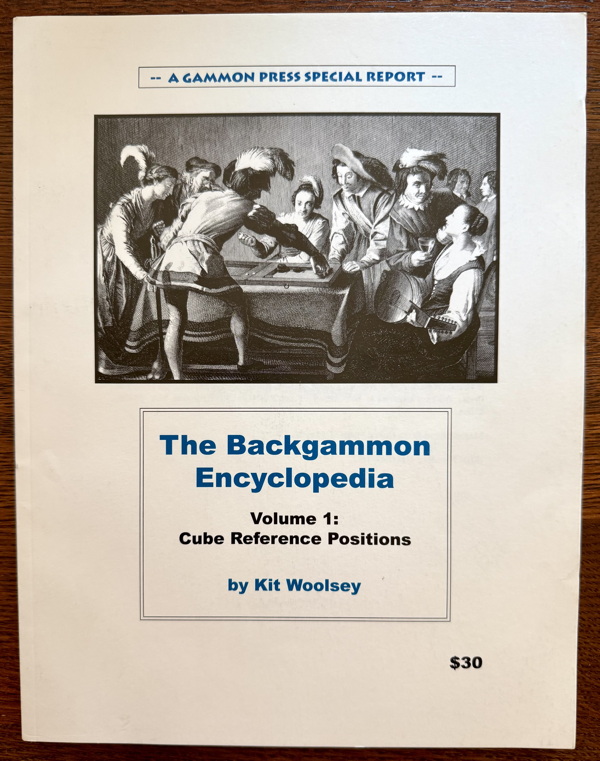 It might seem that stronger players must be mathematical geniuses, or just have a powerful but mysterious intuition about the proper time to double, and when to pass . . . but mostly they just know lots and lots of reference positions. These are sharply defined, illustrative positions that represent a common type of situation you encounter over the board. By comparing the position in front of them to a known reference position they’ve studied, experts can make confident and accurate decisions. In these two volumes of “Cube Reference Positions,” Kit Woolsey lays out a host of such positions guiding cube action in 19 categories covering all sorts of blitzes, holding games, races, back games, and touchy situations where you have a checker or two on the bar. Absolutely essential are the chapters on Holding Games and Post Ace-Point games. Long out of print, this essential resource has recently been made available as a digital e-book on Justin Nowell’s Backgammon University site.
It might seem that stronger players must be mathematical geniuses, or just have a powerful but mysterious intuition about the proper time to double, and when to pass . . . but mostly they just know lots and lots of reference positions. These are sharply defined, illustrative positions that represent a common type of situation you encounter over the board. By comparing the position in front of them to a known reference position they’ve studied, experts can make confident and accurate decisions. In these two volumes of “Cube Reference Positions,” Kit Woolsey lays out a host of such positions guiding cube action in 19 categories covering all sorts of blitzes, holding games, races, back games, and touchy situations where you have a checker or two on the bar. Absolutely essential are the chapters on Holding Games and Post Ace-Point games. Long out of print, this essential resource has recently been made available as a digital e-book on Justin Nowell’s Backgammon University site.
The Backgammon Encyclopedia Vol. 2 (2017) - Kit Woolsey
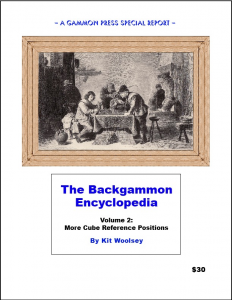 The long-awaited second volume of doubling reference positions from Kit Woolsey covers ten additional scenarios where you’ll want to consider shipping (or passing) a cube. Chapter headings include novel concepts like “The Semi Blitz” and familiar situations where it can be particularly vexing to discern the proper cube action: “Containment,” “Escape,” “Crunching.” On the whole the sections seem a bit less sharply defined than those in Volume 1 (it would make sense that Woolsey would go after the most useful scenarios first), but there’s plenty here worth harvesting.
The long-awaited second volume of doubling reference positions from Kit Woolsey covers ten additional scenarios where you’ll want to consider shipping (or passing) a cube. Chapter headings include novel concepts like “The Semi Blitz” and familiar situations where it can be particularly vexing to discern the proper cube action: “Containment,” “Escape,” “Crunching.” On the whole the sections seem a bit less sharply defined than those in Volume 1 (it would make sense that Woolsey would go after the most useful scenarios first), but there’s plenty here worth harvesting.
Cube Like a Boss (2019) - Marc Olsen
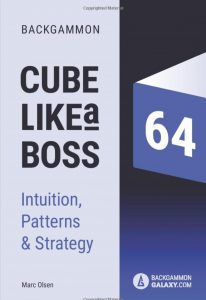 Backgammon has been long overdue for a good general-purpose introduction to doubling, and Marc Olsen’s book is currently the only quality entry in the field. For the sake of novice doublers, it might have been useful to lay out the vital concepts covered in “Chapter 0” more gradually, using illustrative examples rather than simply stating definitions, but Olsen is clearly eager to get to the main attraction. Cube Like a Boss methodically covers 14 of the distinctive scenarios where cube action most typically arises (Early Bliss, Holding Game, Prime vs. Prime, etc). It’s not a book that’s easy to absorb in a cover-to-cover reading, so students of the game will do best concentrating on one section at a time — perhaps going to the appropriate chapter when you discover over the board that you really don’t know how to think about doubling in certain situations, and then engaging in some deliberate practice against XG, drilling on the scenario. If you can integrate Olsen’s guidance in your play, you will indeed become a boss cube handler.
Backgammon has been long overdue for a good general-purpose introduction to doubling, and Marc Olsen’s book is currently the only quality entry in the field. For the sake of novice doublers, it might have been useful to lay out the vital concepts covered in “Chapter 0” more gradually, using illustrative examples rather than simply stating definitions, but Olsen is clearly eager to get to the main attraction. Cube Like a Boss methodically covers 14 of the distinctive scenarios where cube action most typically arises (Early Bliss, Holding Game, Prime vs. Prime, etc). It’s not a book that’s easy to absorb in a cover-to-cover reading, so students of the game will do best concentrating on one section at a time — perhaps going to the appropriate chapter when you discover over the board that you really don’t know how to think about doubling in certain situations, and then engaging in some deliberate practice against XG, drilling on the scenario. If you can integrate Olsen’s guidance in your play, you will indeed become a boss cube handler.
Holding Game Guru (2021) - Jacob "Stick" Rice
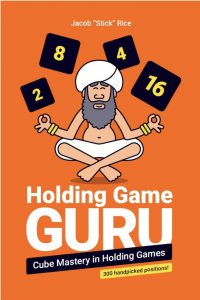 Studying holding game cube action is one of the very best investments of time you can make as a competitive player. They just come up so regularly that you’re going to benefit over and over again for even small improvements in play. In this first book-length offering from respected author of the BackgammonVillage “Sticks and Stones” series of articles, Jacob “Stick” Rice shares his arsenal of four Rules and ten Reference Positions and then goes on to analyze a whopping 300 non-obvious holding game cube positions to thoroughly illustrate the considerations that lead to proper play. The positions don’t appear to be grouped or ordered in any particular way (there is a chapter division between the first and second halves of 150 positions, but no suggestion why), perhaps intended to emulate actual play, where every variety of holding game will appear at random. Rice’s analysis is concise and engagingly colloquial, modeling an approach to reasoning over the board that readers can hope to emulate. The book design is also excellent, with a perfect balance of text and clearly-rendered diagrams.
Studying holding game cube action is one of the very best investments of time you can make as a competitive player. They just come up so regularly that you’re going to benefit over and over again for even small improvements in play. In this first book-length offering from respected author of the BackgammonVillage “Sticks and Stones” series of articles, Jacob “Stick” Rice shares his arsenal of four Rules and ten Reference Positions and then goes on to analyze a whopping 300 non-obvious holding game cube positions to thoroughly illustrate the considerations that lead to proper play. The positions don’t appear to be grouped or ordered in any particular way (there is a chapter division between the first and second halves of 150 positions, but no suggestion why), perhaps intended to emulate actual play, where every variety of holding game will appear at random. Rice’s analysis is concise and engagingly colloquial, modeling an approach to reasoning over the board that readers can hope to emulate. The book design is also excellent, with a perfect balance of text and clearly-rendered diagrams.
Match play
Once you’ve achieved a solid competency in doubling (with the help of the guides in the previous section), you’ll want to delve into the subtleties of match play, where lopsided scores or proximity to victory can radically affect optimal cube actions. Here are some writers who can offer help.
How to Play Tournament Backgammon (1993) - Kit Woolsey
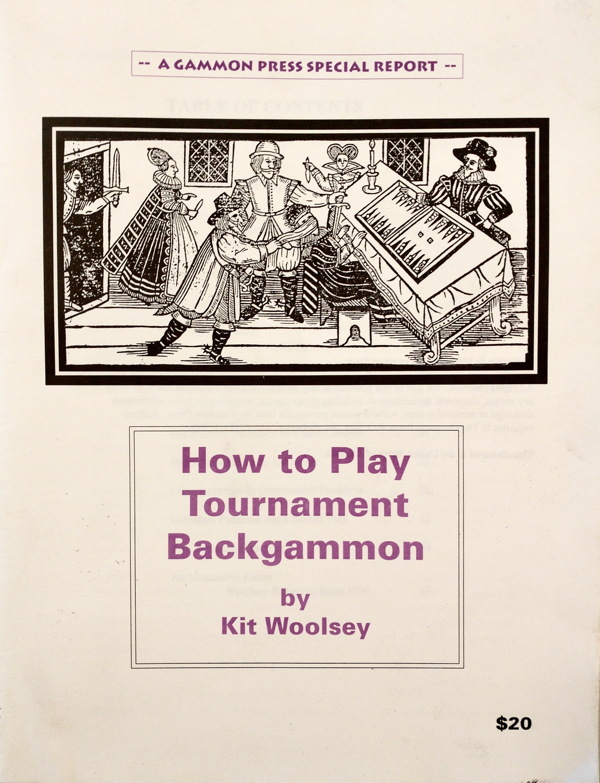 In this landmark publication, Kit Woolsey lays out the fundamental tools for adjusting cube action to Match-play scores. The essential premise is that the marginal value of a point, and hence the risk-reward equation for doubling, changes depending upon how many points each player needs to win a match. You’ll be introduced to the Match Equity Table and invited to either learn it by heart or learn how to apply tools like Kanowski’s formula to generate the relevant figures in the heat of a match. Then Woolsey goes on to show how to use these figures to calculate your potential cost or benefit from doubling or taking at various scores. The mental math involved will be a very heavy lift for many players — so heavy in fact, that when I first read this in the mid-1990’s in the midst of a long tournament slump, I essentially concluded match play wasn’t for me and abandoned tournaments for a decade, sticking to money play and chouettes. You’ll find more accessible help in the later texts in this section, and even in Woolsey’s far more accessible account of cube adjustments at all scores in his short paper Five Point Match. Still, even for the less numerate player, reading this treatise on the mathematical principles underlying match-play doubling strategy is good preparation for reading later guides, putting in place a foundation to build upon. So, if you’re a mental math whiz, this is for you — or maybe even if you aren’t.
In this landmark publication, Kit Woolsey lays out the fundamental tools for adjusting cube action to Match-play scores. The essential premise is that the marginal value of a point, and hence the risk-reward equation for doubling, changes depending upon how many points each player needs to win a match. You’ll be introduced to the Match Equity Table and invited to either learn it by heart or learn how to apply tools like Kanowski’s formula to generate the relevant figures in the heat of a match. Then Woolsey goes on to show how to use these figures to calculate your potential cost or benefit from doubling or taking at various scores. The mental math involved will be a very heavy lift for many players — so heavy in fact, that when I first read this in the mid-1990’s in the midst of a long tournament slump, I essentially concluded match play wasn’t for me and abandoned tournaments for a decade, sticking to money play and chouettes. You’ll find more accessible help in the later texts in this section, and even in Woolsey’s far more accessible account of cube adjustments at all scores in his short paper Five Point Match. Still, even for the less numerate player, reading this treatise on the mathematical principles underlying match-play doubling strategy is good preparation for reading later guides, putting in place a foundation to build upon. So, if you’re a mental math whiz, this is for you — or maybe even if you aren’t.
Cubes and Gammons Near the End of the Match (1997) - Antonio Ortega & Danny Kleinman
 This intensely quantitative analysis of match-play situations where one or both players have reached a “2-away” score. The book looks first at situations when the trailer doubles, and then goes the other way and examines Leader doubles. And then they even spend nine pages scrutinizing the 2-away / 2-away scenario! Both Ortega and Kleinman rarely seem happier than when calculating doubling windows, running positions through Jellyfish, and offering positional analyses where numerals out-number letters. If you found Woolsey’s 1993 treatise mathematically daunting, here’s an even longer bridge to cross.
This intensely quantitative analysis of match-play situations where one or both players have reached a “2-away” score. The book looks first at situations when the trailer doubles, and then goes the other way and examines Leader doubles. And then they even spend nine pages scrutinizing the 2-away / 2-away scenario! Both Ortega and Kleinman rarely seem happier than when calculating doubling windows, running positions through Jellyfish, and offering positional analyses where numerals out-number letters. If you found Woolsey’s 1993 treatise mathematically daunting, here’s an even longer bridge to cross.
Can a Fish Taste Twice as Good? (1993) - Jake Jacobs & Walter Trice
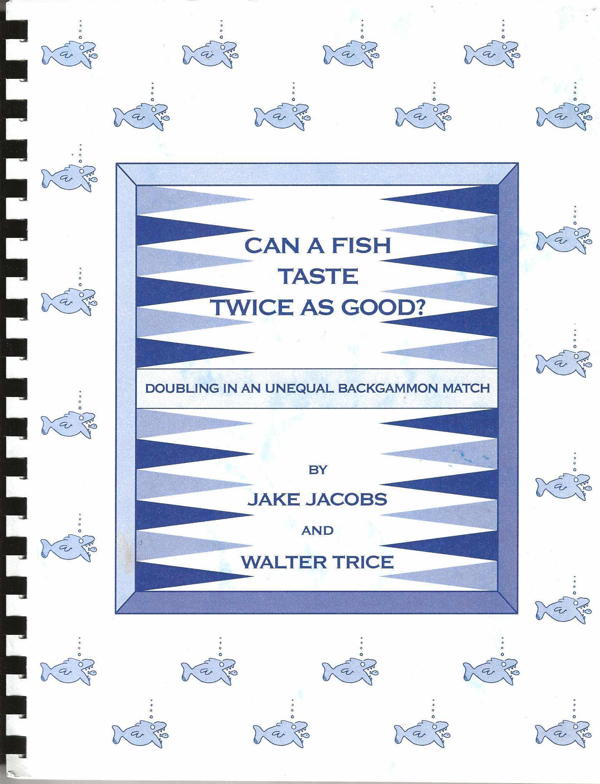 Quite often you will overhear a player at an ABT tournament confide that would have played a roll or handled the cube differently, “only I was playing a much weaker opponent, so I ——.” Personally, I hear this more often from strong intermediate players than I hear it from grandmasters, most of whom just try to “do the right thing” with deadly consistency. But then, intermediates will be more likely to encounter far weaker players in their division, so maybe they have a point? If you want to take this issue seriously, and you bring some serious mathematical chops to the game, this is the book for you. Jacobs and Trice deployed their genius for numbers to derive adjusted match-equity tables to reflect the winning chances between unequally-matched opponents at various degrees of disparity. A very few backgammon players will be able to appreciate the intellectual subtleties of this remarkable treatise, and fewer still will be able to put its insights to practical use. For the rest of us, just figuring out the theoretically correct thing to do in a given situation is challenge enough! This isn’t to say that judicious adjustments due to skill differences aren’t warranted — just that this book isn’t likely to help most of us decide when it’s a good idea.
Quite often you will overhear a player at an ABT tournament confide that would have played a roll or handled the cube differently, “only I was playing a much weaker opponent, so I ——.” Personally, I hear this more often from strong intermediate players than I hear it from grandmasters, most of whom just try to “do the right thing” with deadly consistency. But then, intermediates will be more likely to encounter far weaker players in their division, so maybe they have a point? If you want to take this issue seriously, and you bring some serious mathematical chops to the game, this is the book for you. Jacobs and Trice deployed their genius for numbers to derive adjusted match-equity tables to reflect the winning chances between unequally-matched opponents at various degrees of disparity. A very few backgammon players will be able to appreciate the intellectual subtleties of this remarkable treatise, and fewer still will be able to put its insights to practical use. For the rest of us, just figuring out the theoretically correct thing to do in a given situation is challenge enough! This isn’t to say that judicious adjustments due to skill differences aren’t warranted — just that this book isn’t likely to help most of us decide when it’s a good idea.
Adjusting to Match Play (2022) - Nick Blasier
 With this offering, Nick Blasier fills one of the most significant and long-standing gaps in the literature of backgammon: adjusting cube action at various match scores. The last book devoted to the topic, Kit Woolsey’s How to Play Tournament Backgammon (1993 – thirty years earlier!) laid out match play theory in a rigorous mathematical model involving memorization of match equity tables and a lot of mental calculation of doubling windows. Blasier, building upon an adjustment model developed by David Presser and Igor Erovenko, offers a more qualitative system of understanding when, and to what degree, cube action at various match scores departs from standard cube action in “money play.” With this method, the student develops a familiarity with specific cube dynamics associated with various specific match scores and learns to make adjustments more intuitively than mathematically. A great way to approach this topic is to study the text gradually, supplementing the reading with practice sessions against XG at the various scores. For instance, set up XG to a 4-away/4-away score and just play games out until you reach an initial cube action, and look at how that action differs from the proper cube action “for money.” After studying Nick’s book, you’ll greet tricky match scores like old friends.
With this offering, Nick Blasier fills one of the most significant and long-standing gaps in the literature of backgammon: adjusting cube action at various match scores. The last book devoted to the topic, Kit Woolsey’s How to Play Tournament Backgammon (1993 – thirty years earlier!) laid out match play theory in a rigorous mathematical model involving memorization of match equity tables and a lot of mental calculation of doubling windows. Blasier, building upon an adjustment model developed by David Presser and Igor Erovenko, offers a more qualitative system of understanding when, and to what degree, cube action at various match scores departs from standard cube action in “money play.” With this method, the student develops a familiarity with specific cube dynamics associated with various specific match scores and learns to make adjustments more intuitively than mathematically. A great way to approach this topic is to study the text gradually, supplementing the reading with practice sessions against XG at the various scores. For instance, set up XG to a 4-away/4-away score and just play games out until you reach an initial cube action, and look at how that action differs from the proper cube action “for money.” After studying Nick’s book, you’ll greet tricky match scores like old friends.
Backgammon: the 7 Point Match (2025) - Simon Barget
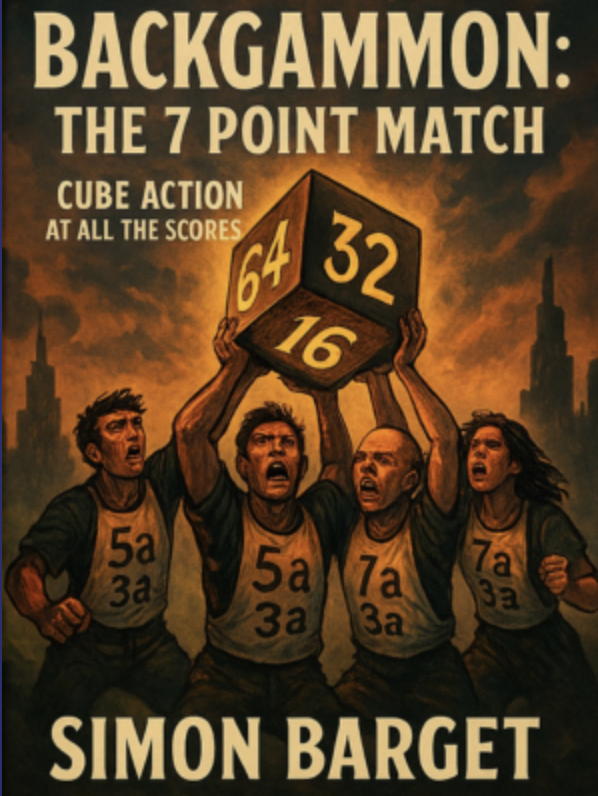 Simon Barget addresses the challenge of adjusting cube action according to match-score by placing all possible scores in a 7-point match on a color-coded “activity spectrum” that indicates how radically proper cube action diverges from what you would do at the beginning 0-0 score (sometime referred to as “normal match score” (NMS) and a reasonable proxy for ‘money play’). Barget emphasizes the crucial distinction between gammonish and non-gammonish positions by providing a separate activity spectrum for the two cases, which is an invaluable insight in itself and also provides a helpful structure for learning the sensitivities of the various scores. The book is further organized by the use of ten positions (five gammonish, five not) that are deployed at each band of the two activity spectrums to illustrate the degree of adjustment at the various scores. While the method is sound, some readers may find the color-coding a bit confusing (is brown a more “active” color than blue – or yellow?), and the inconsistent page layouts, with large amounts of blank space and arbitrary page breaks tend to work against the sharp comparisons that lie at the heart of Barget’s method. The explanatory text is also rather fragmented and may be hard to follow for players who aren’t already conversant with advanced backgammon analysis. But the approach here is a good one, and the book may repay careful study with better PR’s for those equipped to follow its logic.
Simon Barget addresses the challenge of adjusting cube action according to match-score by placing all possible scores in a 7-point match on a color-coded “activity spectrum” that indicates how radically proper cube action diverges from what you would do at the beginning 0-0 score (sometime referred to as “normal match score” (NMS) and a reasonable proxy for ‘money play’). Barget emphasizes the crucial distinction between gammonish and non-gammonish positions by providing a separate activity spectrum for the two cases, which is an invaluable insight in itself and also provides a helpful structure for learning the sensitivities of the various scores. The book is further organized by the use of ten positions (five gammonish, five not) that are deployed at each band of the two activity spectrums to illustrate the degree of adjustment at the various scores. While the method is sound, some readers may find the color-coding a bit confusing (is brown a more “active” color than blue – or yellow?), and the inconsistent page layouts, with large amounts of blank space and arbitrary page breaks tend to work against the sharp comparisons that lie at the heart of Barget’s method. The explanatory text is also rather fragmented and may be hard to follow for players who aren’t already conversant with advanced backgammon analysis. But the approach here is a good one, and the book may repay careful study with better PR’s for those equipped to follow its logic.
Match Transcriptions / Analysis
Bill Robertie will tell you that the era of match-analysis books is over — and they never did as well as “problem” type books anyhow. If so, that’s a pity. With the advent of live match-streaming from backgammon tournaments all over the world along with online resources like Zoom and YouTube, there’s no shortage of free match commentary available with a few clicks of a mouse. But “on the fly” commentary is no substitute for deeply considered analysis, and it’s a shame that books devoted to match analysis have fallen out of fashion, as they also serve to memorialize major contests for posterity.
There is also an exciting new way to engage with these books: play out the matches yourself on Backgammon Studio. (A Premium Studio/Heroes membership is required — and use a Chrome browser, not Safari if you’re a Mac user!) BG Studio’s massive archive of complete matches includes all the matches included in these books, and the site allows you to play as one or the other player, playing out the entire match as a sort of extended quiz — and it evaluates the quality of your play in comparison to the original player! So this is your chance to outplay 1980 Paul Magriel. (Though you’re only challenged on cube decisions when a doubling action occurred or was warranted, so you get a big edge there). Playing through a match and comparing your thought process to the analysis offered in these books is a fantastic learning experience, and a lot of fun. Pro Tip: Follow the match analysis only of the player whose decisions you are making — play through the match a second time as the other player to cover his or her decisions.
Championship Backgammon (1980) - Barclay Cooke & Rene Orlean
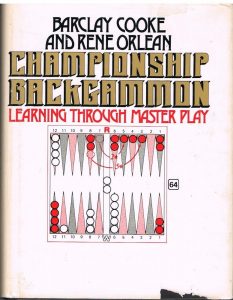 This book provides a fascinating time-capsule view of backgammon as played at the highest levels circa 1973, in a trans-Atlantic throw-down between Barclay Cooke and his son Walter against a British team of Joe Dwek and Philip Martyn, both backgammon writers in their own right. In a somewhat misguided attempt at equalizing the luck factor, the matches were played “duplicate” style, with a single dice roller providing numbers for opposite players on the two boards (a practice dating back to backgammon parties in the early 1930’s). Of course, the two games diverge so quickly that the numbers no longer “mean” the same thing for both games. It seems implied that the commentator’s voice is Rene Orlean, but as Barclay Cooke is co-author as well as contestant, the analysis clearly bears the stamp of his disastrous “pure play style,” promoted in his Paradoxes and Probabilities published two years previously. That Championship Backgammon offers analysis of games played seven years earlier (with promises of a second helping that never arose) without acknowledging any changes in tactics or strategy learned since then suggests . . . overconfidence.
This book provides a fascinating time-capsule view of backgammon as played at the highest levels circa 1973, in a trans-Atlantic throw-down between Barclay Cooke and his son Walter against a British team of Joe Dwek and Philip Martyn, both backgammon writers in their own right. In a somewhat misguided attempt at equalizing the luck factor, the matches were played “duplicate” style, with a single dice roller providing numbers for opposite players on the two boards (a practice dating back to backgammon parties in the early 1930’s). Of course, the two games diverge so quickly that the numbers no longer “mean” the same thing for both games. It seems implied that the commentator’s voice is Rene Orlean, but as Barclay Cooke is co-author as well as contestant, the analysis clearly bears the stamp of his disastrous “pure play style,” promoted in his Paradoxes and Probabilities published two years previously. That Championship Backgammon offers analysis of games played seven years earlier (with promises of a second helping that never arose) without acknowledging any changes in tactics or strategy learned since then suggests . . . overconfidence.
Only the first sixteen of an agreed-upon 40 games are presented here, which is plenty to showcase the thinking of the day, which favored aggressive slotting and making points in order, and worried little about scattering blots around the board (in one game Dwek leaves seven of them!). The commentary also places heavy value on the emotional aspects of the game, and freely attributes plays the writers find wrong-headed to the effects of competitive stress and frustration — even when in fact the plays turn out to be obviously correct today. It’s a reminder that in the days before backgammon ‘bots, backgammon competition seemed like much more of a clash of characters and temperaments than the coolly cerebral game it has become today. And though our play today is technically superior to that of the 1970’s, that’s not to say we’re having more fun.
And as to the results? Barclay vs Joe was the markedly stronger table, with Walt and Phillip trailing their teammates by 3-4 PR. The combined national PR’s were quite close: US (10.36) – GB (10.74).
Barclay Cooke – Joe Dwek file (.txt) Walter Cooke – Phillip Martyn file (.txt)
Backgammon With the Champions (1981-82) - Kent Goulding
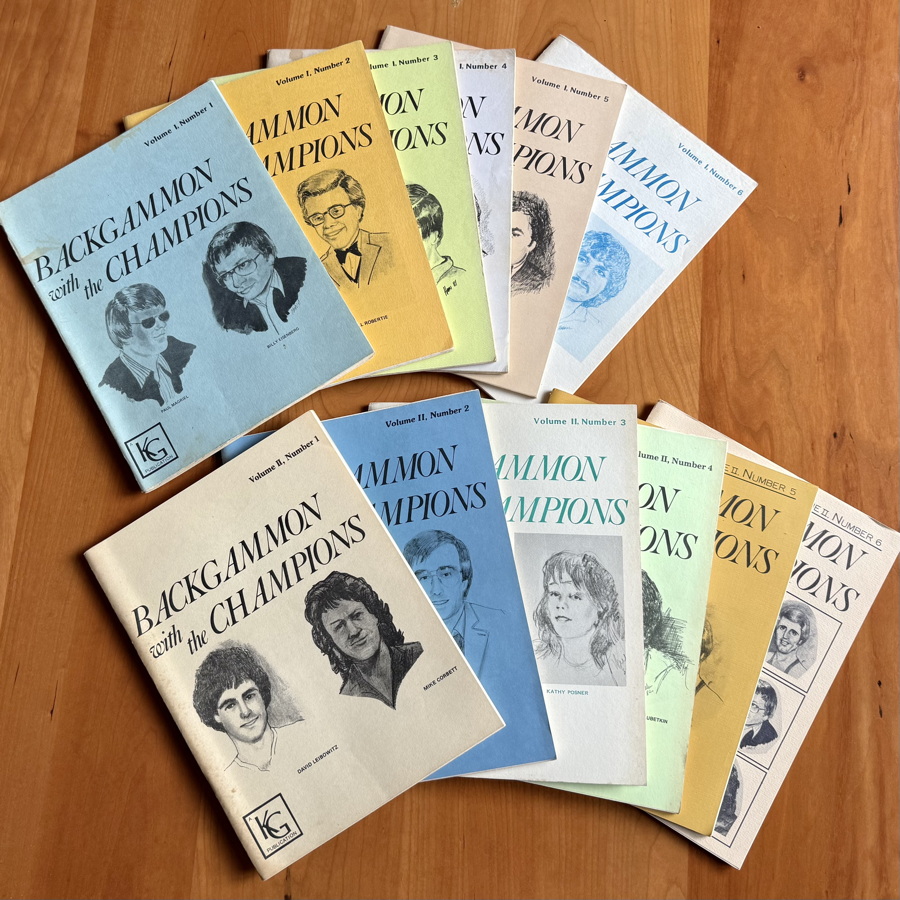 Included here for its historical significance, Kent Goulding’s Backgammon With the Champions elevated the status of backgammon by regularly publishing annotated transcriptions of matches played between the leading lights of the day. While chess transcriptions have long immortalized the brilliancies of its masters, even the most momentous backgammon matches had rarely been transcribed before the 1980’s, perhaps reflecting a view of the game as an ephemeral contest dominated by chance. The twelve issues of this journal capture a couple dozen of the game’s top theoreticians and competitors, in their choices across the board and also in a series of endearing hand-drawn portraits that grace the cover. Goulding’s analysis, along with many guest commentators and sometimes the players themselves, demonstrate the state of the game coming out of backgammon’s heyday of the 1970’s. Also included are early examples of Kit Woolsey’s match equity charts, pointing toward the next wave of sophistication in competitive practice. The series has never been re-printed, and original copies are very hard to come by.
Included here for its historical significance, Kent Goulding’s Backgammon With the Champions elevated the status of backgammon by regularly publishing annotated transcriptions of matches played between the leading lights of the day. While chess transcriptions have long immortalized the brilliancies of its masters, even the most momentous backgammon matches had rarely been transcribed before the 1980’s, perhaps reflecting a view of the game as an ephemeral contest dominated by chance. The twelve issues of this journal capture a couple dozen of the game’s top theoreticians and competitors, in their choices across the board and also in a series of endearing hand-drawn portraits that grace the cover. Goulding’s analysis, along with many guest commentators and sometimes the players themselves, demonstrate the state of the game coming out of backgammon’s heyday of the 1970’s. Also included are early examples of Kit Woolsey’s match equity charts, pointing toward the next wave of sophistication in competitive practice. The series has never been re-printed, and original copies are very hard to come by.
Lee Genud vs. Joe Dwek (1982) - Bill Robertie
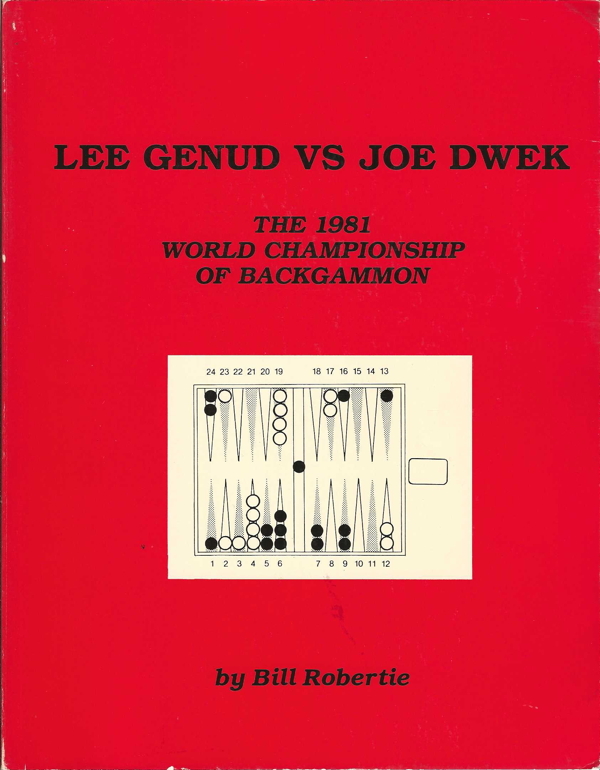 Robertie’s “Red Book” offers a complete transcription along with commentary on the epic 35-game 1981 World Championship final between Lee Genud and Joe Dwek in Monte Carlo. Before the main course, however, Robertie offers up a rigorous 20-page treatise on cube handling in match play that covers much of the ground Kit Woolsey would address a decade later in How to Play Tournament Backgammon. The match analysis itself is notably rigorous, with all cube actions and many checker plays rolled out by hand for 100-300 trials. Additional sections introduce us to the Monte Carlo tournament and to the finalists Genud and Dwek, including their tournament histories. One wishes that all of the world championships could have been commemorated in editions such as this, to further celebrate the top play of the times. Long out of print, this softback has become somewhat collectible.
Robertie’s “Red Book” offers a complete transcription along with commentary on the epic 35-game 1981 World Championship final between Lee Genud and Joe Dwek in Monte Carlo. Before the main course, however, Robertie offers up a rigorous 20-page treatise on cube handling in match play that covers much of the ground Kit Woolsey would address a decade later in How to Play Tournament Backgammon. The match analysis itself is notably rigorous, with all cube actions and many checker plays rolled out by hand for 100-300 trials. Additional sections introduce us to the Monte Carlo tournament and to the finalists Genud and Dwek, including their tournament histories. One wishes that all of the world championships could have been commemorated in editions such as this, to further celebrate the top play of the times. Long out of print, this softback has become somewhat collectible.
Reno 1986 (1987) - Bill Robertie
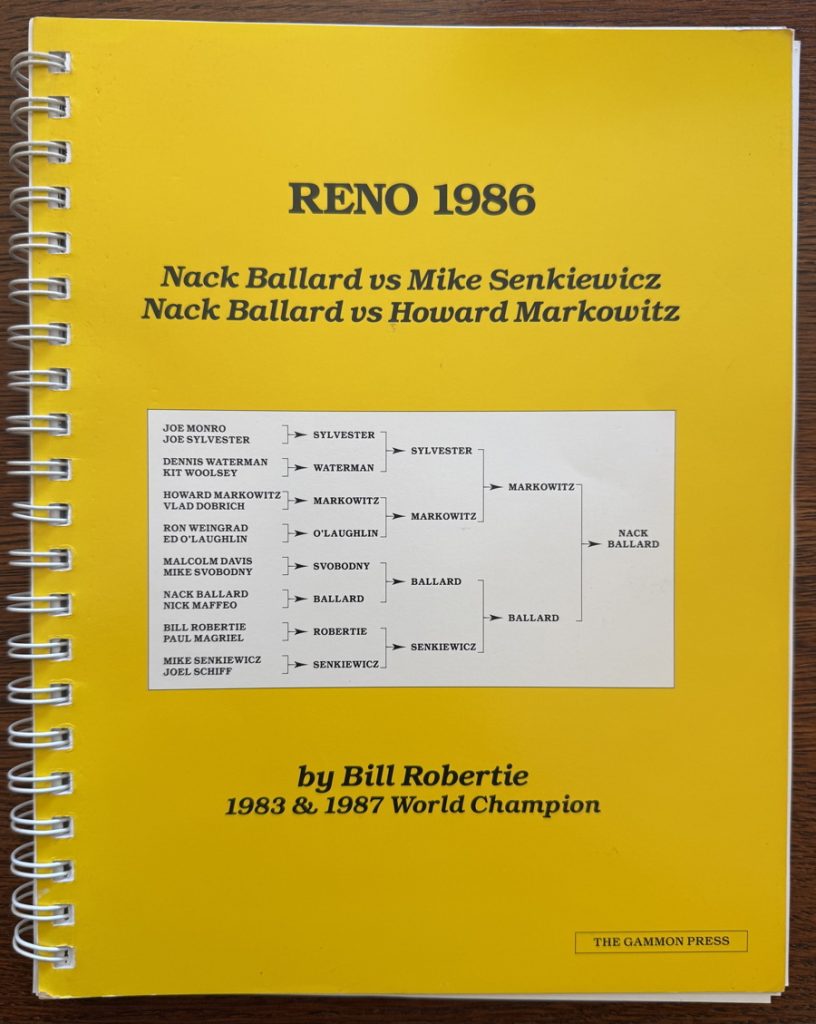 This second helping of backgammon match play analysis from Bill Robertie spotlights Nack Ballard in the act of besting Mike Senkiewicz and Howard Markowitz to win the First Reno Master’s Invitational in 1986. As with Robertie’s ‘Red Book’, Reno offers up a 20-page appetizer: a detailed historical account of the tradition of “Invitational” backgammon tournaments, beginning with the First Blue Ribbon Grandmaster’s Tournament in Miami, Florida (1975). The aim of these exclusive invitationals, limited to the highest-regarded, top-rated players in the game, the better to identify the true best of the best. Massive 128-player draws contested via relatively short matches, though exciting, were unlikely to reliably reward the best players. By limiting the field to 16 players at most, the invitational format could submit its players to grueling 25-point matches against other strong players (nobody gets an ‘easy draw’). To further engage the reader, Robertie included a self-scoring feature to this book, to let us see how we’d stack up against Nack, earning a rating ranging from Grandmaster to Brain-Dead. Long out of print, this spiral-bound tome has become somewhat collectible.
This second helping of backgammon match play analysis from Bill Robertie spotlights Nack Ballard in the act of besting Mike Senkiewicz and Howard Markowitz to win the First Reno Master’s Invitational in 1986. As with Robertie’s ‘Red Book’, Reno offers up a 20-page appetizer: a detailed historical account of the tradition of “Invitational” backgammon tournaments, beginning with the First Blue Ribbon Grandmaster’s Tournament in Miami, Florida (1975). The aim of these exclusive invitationals, limited to the highest-regarded, top-rated players in the game, the better to identify the true best of the best. Massive 128-player draws contested via relatively short matches, though exciting, were unlikely to reliably reward the best players. By limiting the field to 16 players at most, the invitational format could submit its players to grueling 25-point matches against other strong players (nobody gets an ‘easy draw’). To further engage the reader, Robertie included a self-scoring feature to this book, to let us see how we’d stack up against Nack, earning a rating ranging from Grandmaster to Brain-Dead. Long out of print, this spiral-bound tome has become somewhat collectible.
Ballard-Senkiewicz file (.txt) Ballard-Markowitz file (.txt)
World Class Backgammon Move by Move (1988) - Roy Friedman
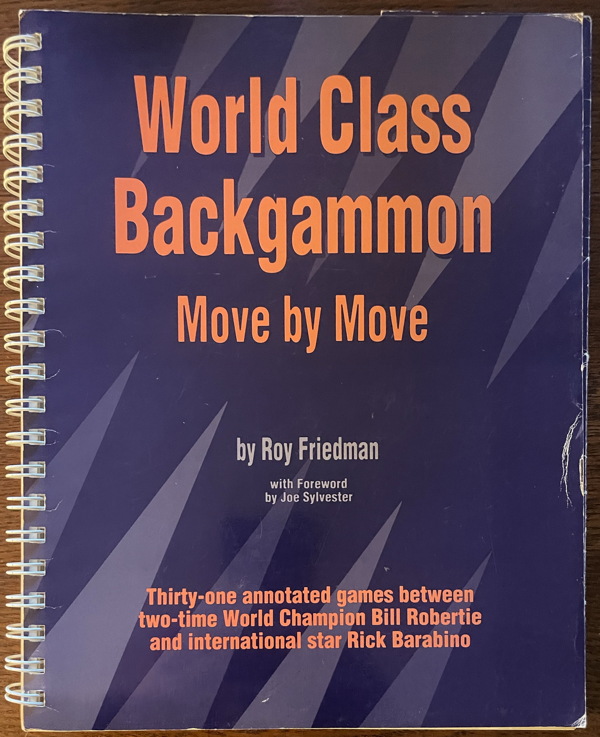 Of particular interest to localNew England backgammon Club members (and alumni!), this match-transcription book comprises the first three matches from the 1987 NEBC Club Championship, which we learn was at that time settled by a brutal best-of 7 series of 9-point matches. Robertie by this time was of course the preeminent competitor and writer in the game, having recently won his second World Championship, while Rick Barabino was a scrappy up-and-comer making waves on the tournament scene. (We hear that Rick was subjected to a fair amount of friendly — and no doubt envious — ribbing for his “International Star” rating on the book’s cover.) Best perused with XG open at your elbow, Friedman’s analysis participates in many of the pre-bot misconceptions of its day, most notably a willingness to leave blots strewn around the board for the sake of greater dynamism. Long out of print, this spiral-bound tome has become somewhat collectible.
Of particular interest to localNew England backgammon Club members (and alumni!), this match-transcription book comprises the first three matches from the 1987 NEBC Club Championship, which we learn was at that time settled by a brutal best-of 7 series of 9-point matches. Robertie by this time was of course the preeminent competitor and writer in the game, having recently won his second World Championship, while Rick Barabino was a scrappy up-and-comer making waves on the tournament scene. (We hear that Rick was subjected to a fair amount of friendly — and no doubt envious — ribbing for his “International Star” rating on the book’s cover.) Best perused with XG open at your elbow, Friedman’s analysis participates in many of the pre-bot misconceptions of its day, most notably a willingness to leave blots strewn around the board for the sake of greater dynamism. Long out of print, this spiral-bound tome has become somewhat collectible.
Robertie-Barabino #1 file (.txt) Robertie-Barabino #2 file (.txt) Robertie-Barabino #3 File (.txt)
*3* "Matchquiz" books from Gammon Press (1994) - Kit Woolsey
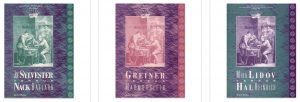 These three books by Kit Woolsey simulate the experience of playing out a match in real time with one of the best, most articulate players in the world at your elbow, coaching you through the thought processes of both players. What’s more, as a trio, they illustrate vividly different match-play scenarios: playing from behind (Greiner/Marmorstein), playing with a lead (Sylvester/Ballard), and pitting a ‘pure’ vs. ‘modern’ style of action (Lidov/Heinrich).
These three books by Kit Woolsey simulate the experience of playing out a match in real time with one of the best, most articulate players in the world at your elbow, coaching you through the thought processes of both players. What’s more, as a trio, they illustrate vividly different match-play scenarios: playing from behind (Greiner/Marmorstein), playing with a lead (Sylvester/Ballard), and pitting a ‘pure’ vs. ‘modern’ style of action (Lidov/Heinrich).
Greiner-Marmorstein file (.txt) Sylvester-Ballard file (.txt) Lidov-Heinrich file (.txt)
Backgammon Praxis, Vols. One & Two (2005) - Marty Storer *Now Available in Print*
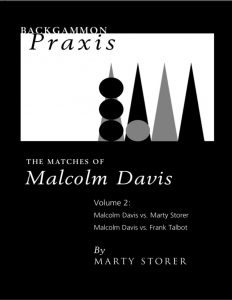 In this monumental study of three matches featuring Malcolm Davis in contests against Ed O’Laughlin, author Marty Storer, and Frank Talbot, Storer produced what is widely regarded as the most substantive and sophisticated match analysis book in the literature. Marty engaged the participants to talk through each game, so reading it feels like sitting at the table with them, as they re-trace their thought processes for the tougher plays and grapple with those decisions that Snowie took issue with in extended rollouts. Storer includes diagrams of alternative plays, so that options can be seen rather than merely visualized, and ends each game with a brief enumeration of “lessons” to be taken away and applied to our own matches. With an original press run of Praxis of only 600 copies, the books were unavailable for years, but have been newly re-issued in 2022 and are now available for sale on Amazon: Volume 1 / Volume 2.
In this monumental study of three matches featuring Malcolm Davis in contests against Ed O’Laughlin, author Marty Storer, and Frank Talbot, Storer produced what is widely regarded as the most substantive and sophisticated match analysis book in the literature. Marty engaged the participants to talk through each game, so reading it feels like sitting at the table with them, as they re-trace their thought processes for the tougher plays and grapple with those decisions that Snowie took issue with in extended rollouts. Storer includes diagrams of alternative plays, so that options can be seen rather than merely visualized, and ends each game with a brief enumeration of “lessons” to be taken away and applied to our own matches. With an original press run of Praxis of only 600 copies, the books were unavailable for years, but have been newly re-issued in 2022 and are now available for sale on Amazon: Volume 1 / Volume 2.
Davis-O’Laughlin file (.txt) Davis-Storer file (.txt) Davis-Talbot file (.txt)
Of Historical Interest
A few books in this section are primarily devoted to backgammon history or to describing the social, organizational, and competitive practices of their own time. Some others were originally intended to be instructive, but are so outdated or misguided that the only real interest in reading them is for the vivid depiction they provide of backgammon in their day.
Playboy's Book of Backgammon (1977) - Lewis Deyong
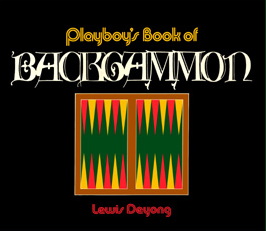 This one is a must-read for anyone interested in the 1960’s – 70’s backgammon scene, as this weighty tome devotes as much space to anecdotal descriptions of backgammon life as to playing techniques. Meet the colorful characters of backgammon’s heyday (including Hugh Hefner, who writes the foreward), and travel the worldwide circuit with this inveterate raconteur: Las Vegas, London, Munich, Athens, Johannesburg, Beirut. Deyong’s idiosyncratic “Seven Pillars of Backgammon” haven’t exactly stood the test of time (anyone out there remember “COMBASM”?) — so you can skim the backgammon advice and just enjoy the story-telling. Pictured is the original hardback cover.
This one is a must-read for anyone interested in the 1960’s – 70’s backgammon scene, as this weighty tome devotes as much space to anecdotal descriptions of backgammon life as to playing techniques. Meet the colorful characters of backgammon’s heyday (including Hugh Hefner, who writes the foreward), and travel the worldwide circuit with this inveterate raconteur: Las Vegas, London, Munich, Athens, Johannesburg, Beirut. Deyong’s idiosyncratic “Seven Pillars of Backgammon” haven’t exactly stood the test of time (anyone out there remember “COMBASM”?) — so you can skim the backgammon advice and just enjoy the story-telling. Pictured is the original hardback cover.
Backgammon Games and Strategies (1977) - Nicolaos & Basil Tzannes
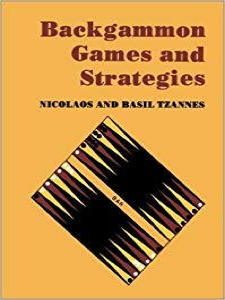 It’s worth remembering that backgammon as we play it is but one variation of the ancient games played on a common backgammon pboard in the Mediterranean and Middle East. The game the Greeks call Portes is the one that has come to dominate international backgammon competition, but many are still passionate about other games like Plakoto, Moultezim, and Gioul. The Tzannes brothers write, “They are by far much more interesting and exciting than [Portes]. Plakoto is without any doubt the king of backgammon games. Moultezim is a serious game for the fundamentalist, the pure strategist, the complete backgammon player.” If you hope to earn the affection of locals in cafes when traveling in Greece, learning how to play these versions of backgammon would be the best way to start.
It’s worth remembering that backgammon as we play it is but one variation of the ancient games played on a common backgammon pboard in the Mediterranean and Middle East. The game the Greeks call Portes is the one that has come to dominate international backgammon competition, but many are still passionate about other games like Plakoto, Moultezim, and Gioul. The Tzannes brothers write, “They are by far much more interesting and exciting than [Portes]. Plakoto is without any doubt the king of backgammon games. Moultezim is a serious game for the fundamentalist, the pure strategist, the complete backgammon player.” If you hope to earn the affection of locals in cafes when traveling in Greece, learning how to play these versions of backgammon would be the best way to start.
Alpha Backgammon (1980) - Baron Vernon Ball
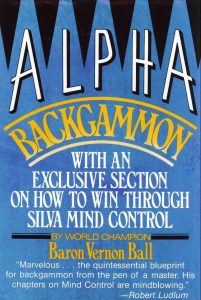 The “luck factor” is a topic of perennial interest to backgammon players, so it’s refreshing to read the advice of a practitioner who decides he’s going to do something about it. If we presume he is in earnest, Baron Vernon Ball must surely rank among the great backgammon philanthropists, showing us how we can improve our dice through “Silva Mind Control” rather than hoarding the technique for personal gain. For instance, in a bear-off with two checkers on one’s own ace-point and an opponent on roll with a checker on the ace- and three- points, Ball encourages us to get busy: “X does not sit idly by and accept as fact that he will lose. X knows that 2-1’s do appear and that he knows how to help make a 2-1 appear more often than probability. X visualizes a 2-1 on his mental screen and concentrates while O is rolling the dice …”(p.186). If this weren’t reason enough to hunt down a copy, Chapter X just might be: Backgammon and Drugs: What Every Player Should Know. “If you have taken more than two or three tokes or smoke more than a single joint and want to play backgammon, find a member of the opposite sex and play for slave time or fun, but don’t expect to perform anywhere near your unstoned abilities.” And don’t even get him started about methaqualone. . .
The “luck factor” is a topic of perennial interest to backgammon players, so it’s refreshing to read the advice of a practitioner who decides he’s going to do something about it. If we presume he is in earnest, Baron Vernon Ball must surely rank among the great backgammon philanthropists, showing us how we can improve our dice through “Silva Mind Control” rather than hoarding the technique for personal gain. For instance, in a bear-off with two checkers on one’s own ace-point and an opponent on roll with a checker on the ace- and three- points, Ball encourages us to get busy: “X does not sit idly by and accept as fact that he will lose. X knows that 2-1’s do appear and that he knows how to help make a 2-1 appear more often than probability. X visualizes a 2-1 on his mental screen and concentrates while O is rolling the dice …”(p.186). If this weren’t reason enough to hunt down a copy, Chapter X just might be: Backgammon and Drugs: What Every Player Should Know. “If you have taken more than two or three tokes or smoke more than a single joint and want to play backgammon, find a member of the opposite sex and play for slave time or fun, but don’t expect to perform anywhere near your unstoned abilities.” And don’t even get him started about methaqualone. . .
Dice, Cubes & Gentlemen (2018) - M. David Sherrill
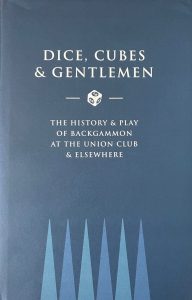 A tome for the committed backgammon historians out there, this limited edition of 500 hardbacks published by the Union Club offers a history of backgammon as played in the world of exclusive New York City gentleman’s clubs. While the copious lists of club champions and award winners may be of interest chiefly to insiders, the book provides entertaining descriptions of the settings and traditions of backgammon play, and encyclopedic illustrated galleries of backgammon books, attractive, illustrations, and facsimiles of early rule sets, as well as a useful historical record of World Champions that we haven’t seen memorialized in book form before. Available while supplies last from Carol Joy Cole’s Backgammon Boutique for a substantial but reasonable $150.
A tome for the committed backgammon historians out there, this limited edition of 500 hardbacks published by the Union Club offers a history of backgammon as played in the world of exclusive New York City gentleman’s clubs. While the copious lists of club champions and award winners may be of interest chiefly to insiders, the book provides entertaining descriptions of the settings and traditions of backgammon play, and encyclopedic illustrated galleries of backgammon books, attractive, illustrations, and facsimiles of early rule sets, as well as a useful historical record of World Champions that we haven’t seen memorialized in book form before. Available while supplies last from Carol Joy Cole’s Backgammon Boutique for a substantial but reasonable $150.
The Backgammon Chronicles (2020) - Robert Wachtel

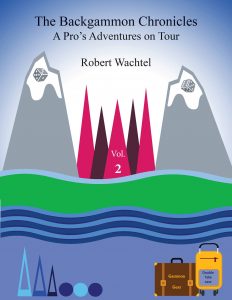 In this richly-illustrated two-volume set, Bob Wachtel captures the contemporary backgammon scene of the past decade our so by relating his wide experience of the game in a dazzling variety of settings and situations, introducing you to many prominent and colorful players of our times. While the focus is on recent history, Bob draws on his earliest days in the game in the late 1970’s as well, providing a useful account of how the traditions, practices, and social conventions surrounding the game have evolved over time — especially due to the advent of the ‘bots. The mode of these volumes is anecdotal and philosophical, so practical backgammon-playing wisdom is only secondary, but the reader will come away with valuable perspectives on how to behave and thrive in the world of competitive backgammon.
In this richly-illustrated two-volume set, Bob Wachtel captures the contemporary backgammon scene of the past decade our so by relating his wide experience of the game in a dazzling variety of settings and situations, introducing you to many prominent and colorful players of our times. While the focus is on recent history, Bob draws on his earliest days in the game in the late 1970’s as well, providing a useful account of how the traditions, practices, and social conventions surrounding the game have evolved over time — especially due to the advent of the ‘bots. The mode of these volumes is anecdotal and philosophical, so practical backgammon-playing wisdom is only secondary, but the reader will come away with valuable perspectives on how to behave and thrive in the world of competitive backgammon.
Backgammon Whimsy
Comic Backgammon - The Meanest Game (1975) - Rick Steed
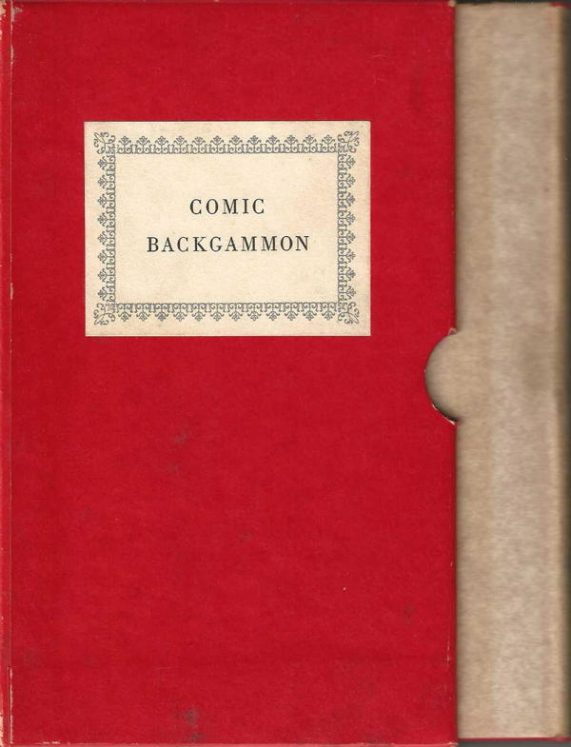
Originally published in 1844, Backgammon: Its History and Practice (by the author of Whist) is a lightly satiric introduction to backgammon accompanied by humorous illustrations. The book was revived in facsimile by Barry Vail packaged as Comic Backgammon in the summer of 1931.The stilted diction and heavy use of literary references is part of the fun, but grows tedious sustained at such length — and one wishes that more of the amusing illustrations by Kenny Meadows included backgammon imagery (most appear to be repurposed engravings given relevance only by captioning). Still, there are some intriguing and amusing sections, including a complete game transcription, eloquent advice about opening plays, and a brief “Laws” chapter almost entirely devoted to imposing strict “touch move” rules. Pictured here is the 1931 reprint in original slipcase.
Backgammon - The Meanest Game (1975) - Rick Steed
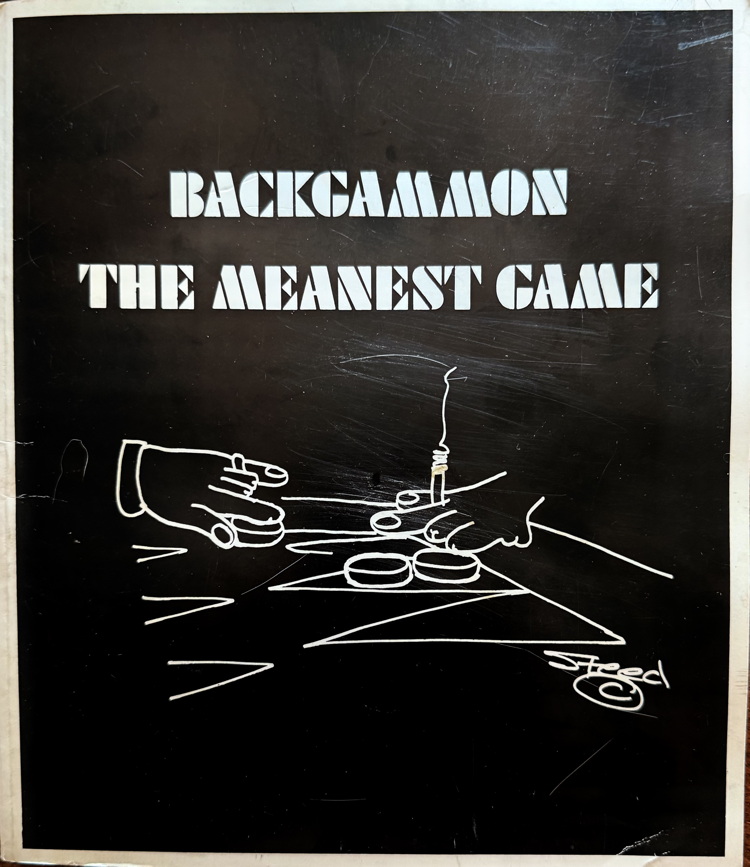 Here’s a true rarity of mysterious origin, whose name parodies the Barclay Cooke title from the previous year. I found my copy, the only known copy, at a Half-Priced Books in San Antonio, but the publication information inside is minimal: Copyright 1975 by Rick Steed, “Dedicated to Marti with special appreciation to the Westside Syndicate,” and “Lettering by Gary Ferguson.” The style is a very familiar 1970’s brand of booze, gambling and crass sex jokes (“Cathy Cleavage” leans over too far and slips out of her halter-top, “exposing a blot”) but shares a lot of the attitude of Taking Some of the Luck Out of Backgammon (1931). Which isn’t really a good thing.
Here’s a true rarity of mysterious origin, whose name parodies the Barclay Cooke title from the previous year. I found my copy, the only known copy, at a Half-Priced Books in San Antonio, but the publication information inside is minimal: Copyright 1975 by Rick Steed, “Dedicated to Marti with special appreciation to the Westside Syndicate,” and “Lettering by Gary Ferguson.” The style is a very familiar 1970’s brand of booze, gambling and crass sex jokes (“Cathy Cleavage” leans over too far and slips out of her halter-top, “exposing a blot”) but shares a lot of the attitude of Taking Some of the Luck Out of Backgammon (1931). Which isn’t really a good thing.
Underhanded Backgammon (1977) - Arthur Prager
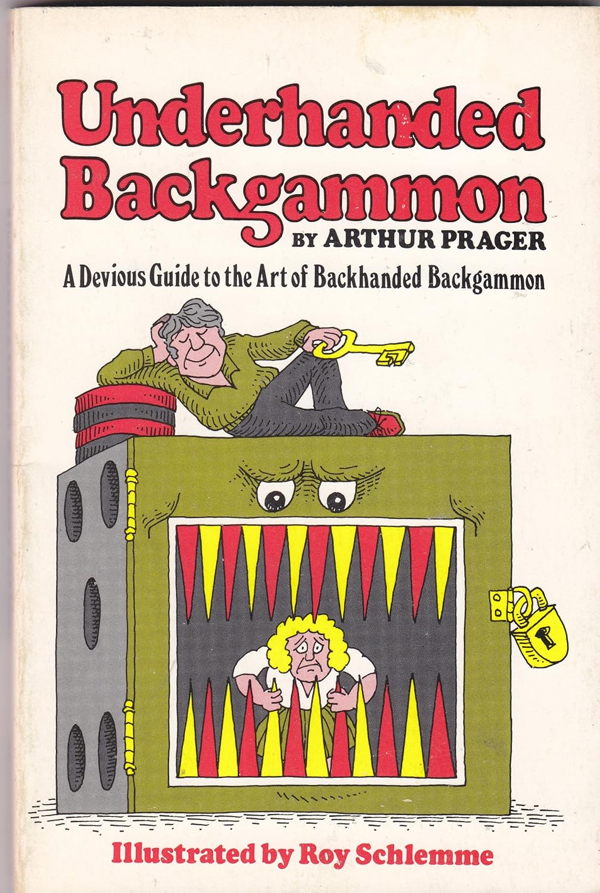 Gifted raconteur Arthur Prater turned his pen to backgammon in this playful account of angle-shooter, opportunists and cheats in our favorite game. There’s a long tradition of holding up familiar “backgammon types” dating back to the 1930’s, and books like this make for vivid snapshots of the backgammon styles and attitudes of the day, warts and all.
Gifted raconteur Arthur Prater turned his pen to backgammon in this playful account of angle-shooter, opportunists and cheats in our favorite game. There’s a long tradition of holding up familiar “backgammon types” dating back to the 1930’s, and books like this make for vivid snapshots of the backgammon styles and attitudes of the day, warts and all.
Color Me Backgammon (2020) - Phyllis Shapiro (et al.)
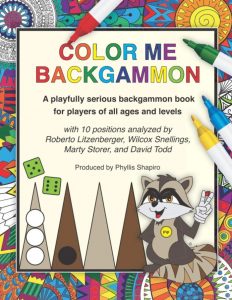 “A playfully serious backgammon books for players of all ages and levels,” this fanciful coloring book offers 10 positions analyzed by respected BG practitioners (Roberto Litzenberger, Wilcox Snellings, Dvid Todd, and our very own Marty Storer!). A stealth tactic for drawing people into the game (come for the coloring, stay for the analysis), this deceptively simple book introduces professional level concepts (complete with XG rollout data in the solutions) in a playful package (including a talking raccoon named Pip).
“A playfully serious backgammon books for players of all ages and levels,” this fanciful coloring book offers 10 positions analyzed by respected BG practitioners (Roberto Litzenberger, Wilcox Snellings, Dvid Todd, and our very own Marty Storer!). A stealth tactic for drawing people into the game (come for the coloring, stay for the analysis), this deceptively simple book introduces professional level concepts (complete with XG rollout data in the solutions) in a playful package (including a talking raccoon named Pip).
The Backgammon Gourmet (2023) - Phyllis Shapiro, Marty Storer (et al.)
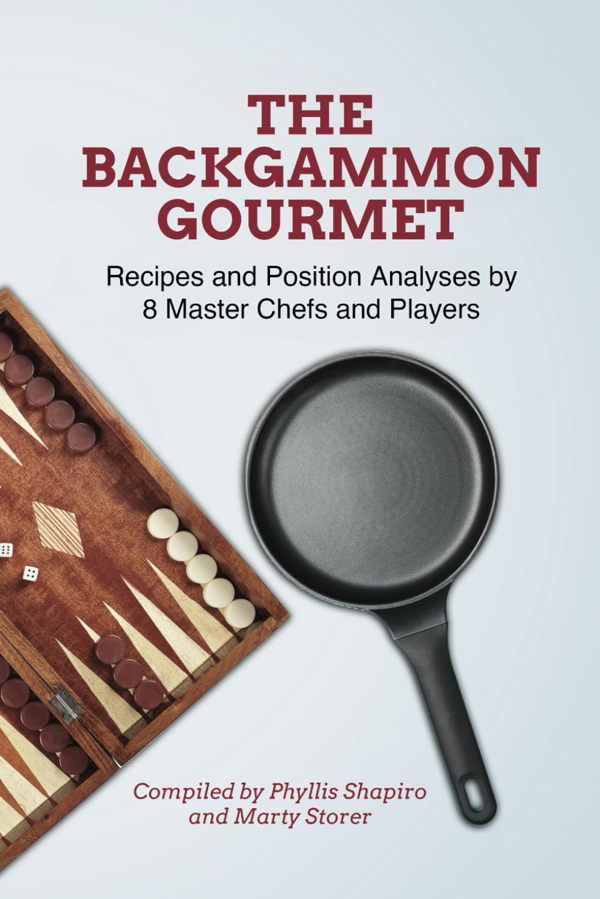 A playful follow-up to Color Me Backgammon is this celebrity cookbook in which a number of familiar names in the backgammon community offer two backgammon positions with analysis accompanied by a pair of recipes thematically linked to the backgammon action. Here’s your chance to learn how I make my martinis — and follow-up “hangover eggs” for the morning after! Other contributors include
A playful follow-up to Color Me Backgammon is this celebrity cookbook in which a number of familiar names in the backgammon community offer two backgammon positions with analysis accompanied by a pair of recipes thematically linked to the backgammon action. Here’s your chance to learn how I make my martinis — and follow-up “hangover eggs” for the morning after! Other contributors include
Want More?
This bibliography is far from comprehensive. For a more complete list of books written on backgammon, complete with publisher’s information, page lengths, and Tables of Contents, visit Tom Keith’s Backgammon Galore! Books page, which reaches back all the way to 1844. Keith’s listings also feature quoted reviews of books that he harvested from online forums and publications.
Also available on the same site, but difficult to find from the homepage, is Art Grater’s remarkable bibliography of backgammon-related books and articles dating back to the 1800’s.

